A marketing tech stack is a necessity for any business no matter the size or reach. Every website can benefit from different types of technology – something many martech companies have proven so far!
But, what is a tech stack?
In short, a marketing technology stack is a variety of software tools that enhance your website. These marketing tools (also know as tech stacks) can help companies solve problems such as:
- Automating repetitive processes
- Enhancing and personalizing communication with customers
- Providing ways to measure website visitor behavior
- Tracking performance of marketing campaigns
In 2020, there were over 8000 marketing technology providers competing for peoples’ attention. And the number only grows.
There is clearly a high level of competition among marketing technology companies!
Luckily, we have narrowed this tiny list down to the best 60+ martech stack examples for 2021. Each tech stack involves software that typically performs better than the majority of its competitors.
To help you find the right tech stack for your business, we looked at different business models. Each company has a unique blend of MarTech Stacks that contributes greatly to its evolution over time. So, let’s check them out!
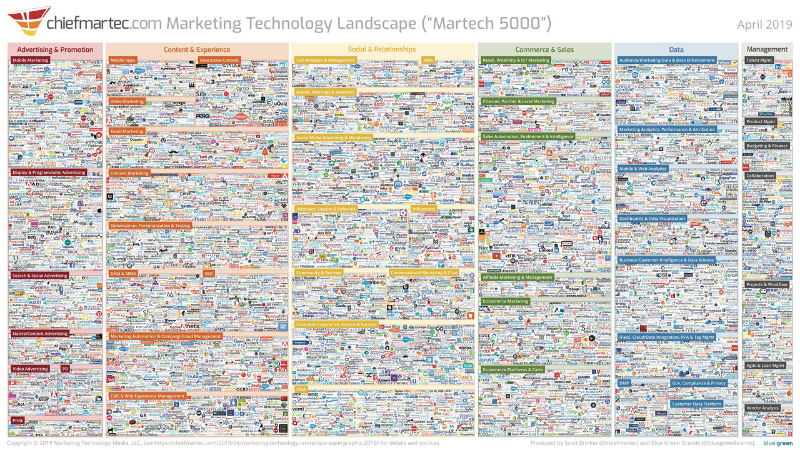
Table of Contents
Marketing Tech Stack Examples 2021
Marketing Technology Stack 2021: Third Door Media
Third Door Media, the organizer of the MarTech Conference has their tech stack visualization presented graphically.
The design they presented is a floor plan of the conference split into sections of different martech stack tools they are using. (Quite witty, right?)
The sections are divided into 6 categories, where Productivity, Amplification, and Infrastructure account for the largest number of tech stack solutions.
More importantly, more than half (52%) of the marketing technology tools they are using are free of charge.
Of the total 108 technology stack solutions they are using, you can come across ones like Salesforce, Buzzsumo, GSuite, etc.
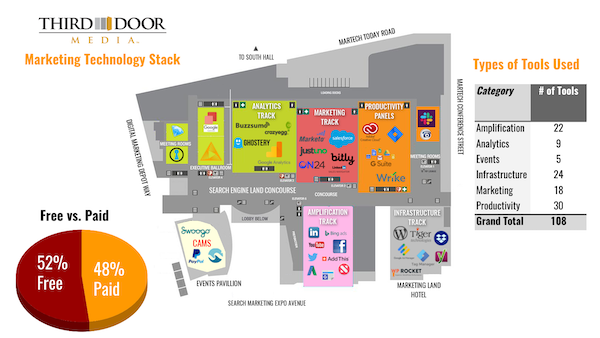
Martech Stack Examples: Paychex
Paychex’s presentation of a digital tech stack resembles an inventory that guides the company to qualified leads.
The categories of 42 boxes with different tech stack tools are organized by their purpose, automatization, and phase of their use. What’s more, they have created blocks ranging from fully automated to fully manual tech stacks.
Once they have the qualified leads ready, they are divided into two phases – grading (may come back to nurture and lead generation) and “shipment”. Very straightforward and easy to navigate!
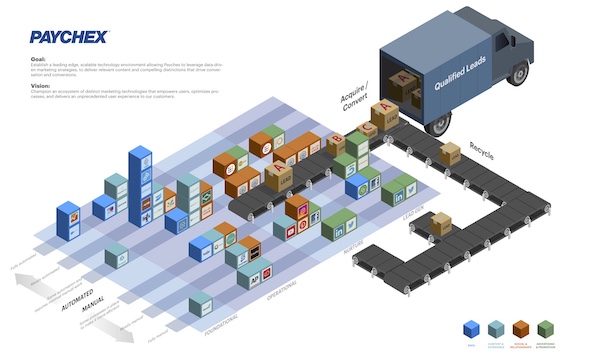
Marketing Tech Stack 2021: Airstream
Airstream, an American brand of travel trailers presented their marketing stack in the form of camping.
Five camping destinations stand for five martech stack categories, out of which Engagement is the most pursued one.
Probably a bit of reach when it comes to clever metaphorical examples of marketing technology stacks. However, still interesting and fun to look at.
Furthermore, the size of the trees shows how much the company works on a given platform. Accordingly, we can see that the company primarily focuses on interaction with its potential customers, by using various social media platforms and tools.
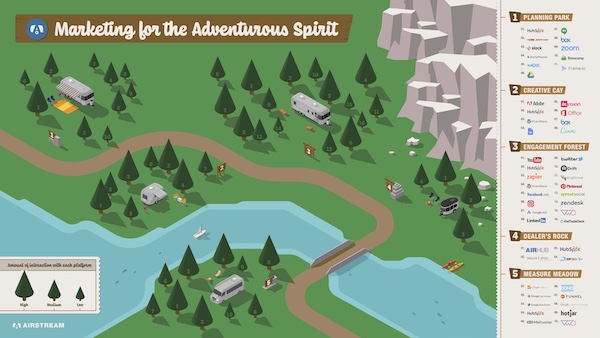
Marketing Tech Stack: Sargento Foods
An American cheese company, Sargento, showed their tech stacks in the form of a recipe.
Their 2020 marketing technology stack solution is scrambled into 4 stages where different platforms are in use. These stages include:
- Planning
- Creating
- Activating
- Measuring
Sargento Foods engages mostly in e-commerce, sales, and creative campaigns (which can be seen in the piecharts on the bottom of infographics).
This is a great example of the ways technology marketers use a digital marketing stack and shows that not only SAAS (software as a service) companies are being tech-savvy.
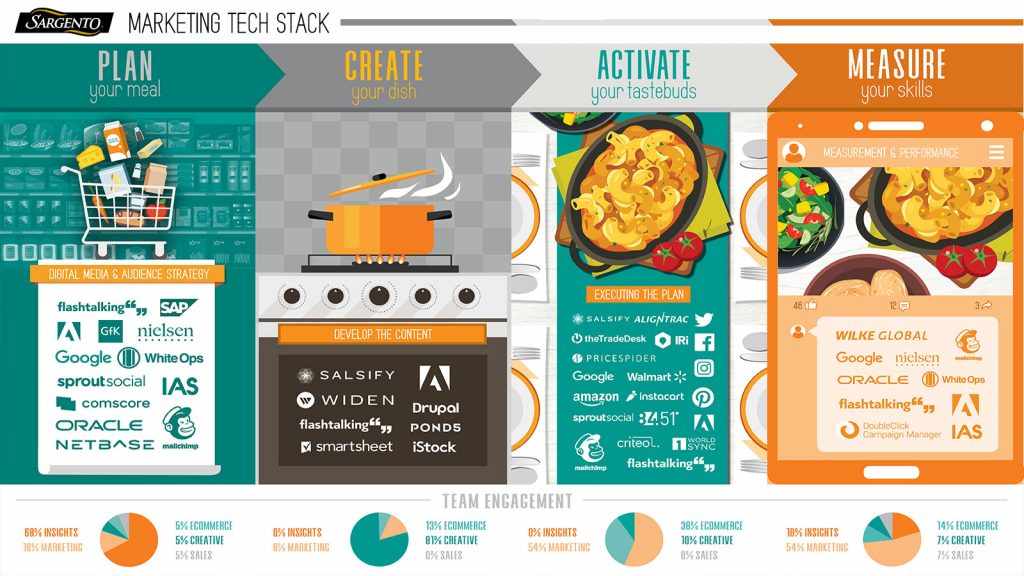
MarTech Stack Examples: Juniper Networks
Networking and cybersecurity solutions company, Juniper, is mentioned as one of the more creative Marketing Tech Stacks of 2020. Their MarTech stack example contains 3 customer lifecycle clouds:
- Pre-sales
- Post-sales
- Pre and post-sales marketing.
Above all, their martech stack is easy to follow thanks to five different functional layers including:
- Sales
- Data
- Relationships and social
- Content and experience
- Management
Additionally, they are one of the martech companies using the PathFactory tool to propose the best customer journey experience for their customers. Great layout and extremely useful marketingtech tools for businesses!
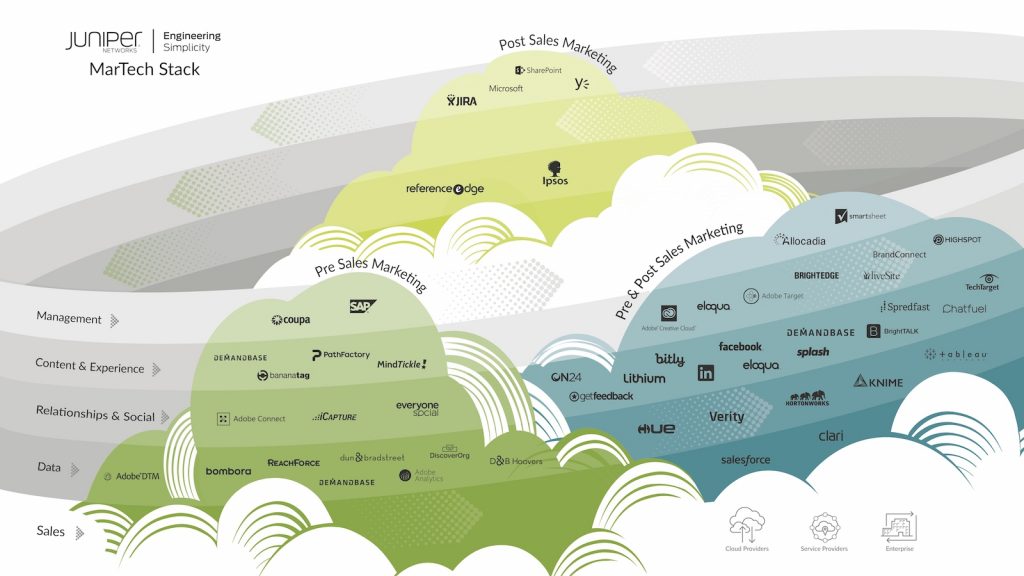
Marketing Tech Stack Terrain: ESRI
ESRI’s infographic on tech stacks is constructed as a map; inspired by what the company is all about. The example presented follows a path through the listed marketing technology stacks used by ESRI’s technology marketers.
The marketing initiative cycle splits into six main categories of marketing:
- Acquisition
- Nurturing
- Retention
- Insights and Analytics
- Productivity
- Communication
A total of 24 tools run the whole operation of ESRI. Tools like Salesforce, Moz, Pardot are crucial parts of their technology stack.
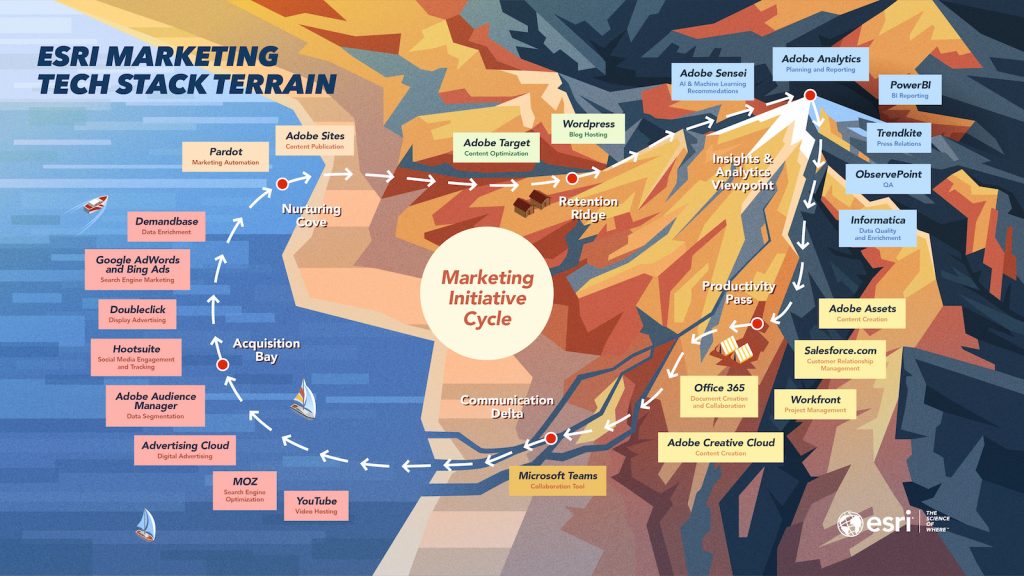
Marketing Technology Stack Strategy: BlackRock
Financial planning company BlackRock won Technology Stacks Award in 2018.
Their martech stack example contains a place called MarTechtropolis. It is a four-district city, where each area presents different marketing strategies.
These are:
- Discovery
- Concept
- Plan
- Do
Moreover, their marketingtech stack solution focuses more on analytics, management, and execution rather than on social media.
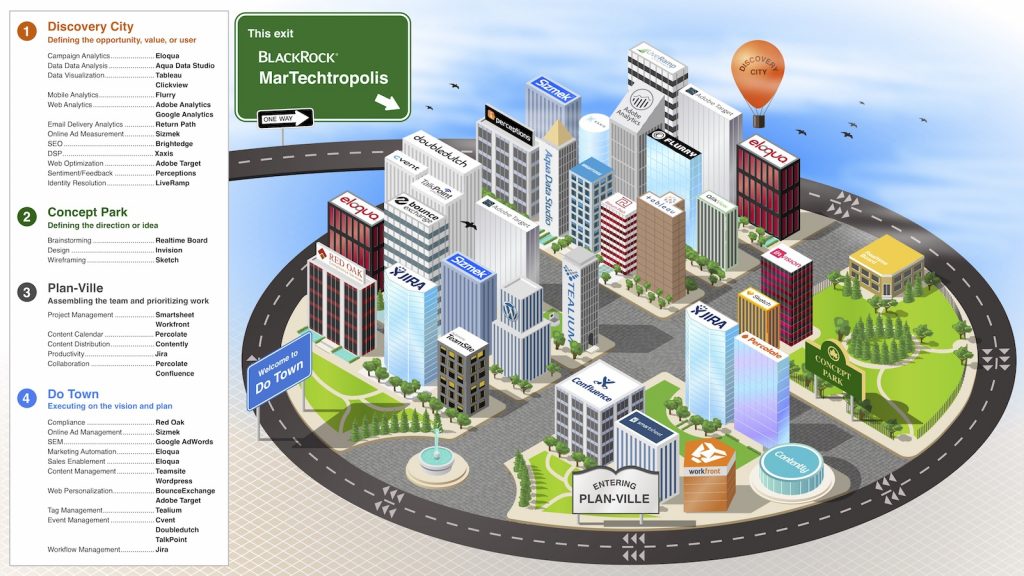
Modern and Open MarTech Stack: McGaw.io
A tech stack management consultancy, McGaw.io, visualized their stack with their public WISIWYG stack builder. The solution is expressed as a flow of data where the tools integrate with each other. The stack is made to follow the evolving marketing analytics trends, and it works like this:
- The stack starts with the customer data platform Segment, which also serves as the backbone and the Rosetta stone for the APIs of the tools in the stack. It sends consolidated data downstream and it also receives data
- Amplitude is the user behavior analytics platform that sends data to the tools that execute marketing campaigns and messaging. Amplitude in this stack also sends data back to Segment, for consolidation.
- Iterable is the customer experience platform that receives and sends data in multiple directions; an important tool in managing the customer touch points
- Salesforce is the main CRM. It’s enriched with offline phone call data from CallRail, and with sales engagement data from SalesLoft.
- Intercom is the customer support platform. It’s connected into customer experience management via Zapier’s automations.
- Snowflake is all the way downstream, as the data warehouse

Marketing Tech Stack 2021: Earth Networks
The meteorological company showed their platforms in a form of weather fronts that contains three of their primary marketing efforts.
Color-coded tools are categorized by different software used for attracting, engaging, or analyzing customers. The software are then divided into five groups standing for:
- Content Creation
- Distribution
- Customer Experience
- Website
- Data Management
Earth Networks received the 2018 Stacks Award for their creative way of presentation, which closely linked marketing technology with what the company does.
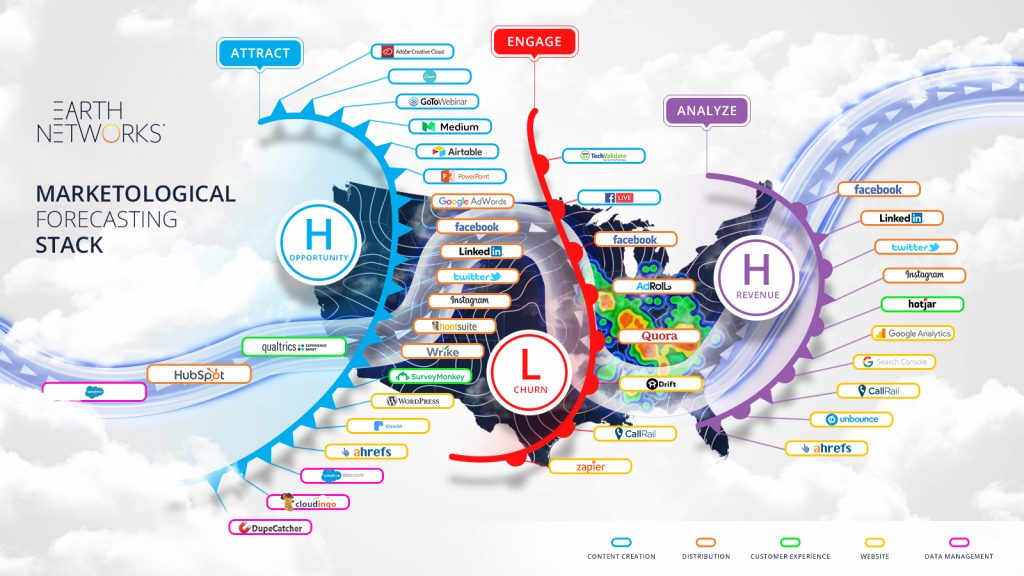
Marketing Technology Stack for Digital Engagement: Cisco
An IT global leader follows their customers’ journey with the help of 43 different marketing technology platforms.
Each of the marketing tech tools contributes to different stages of the lead nurturing funnel (you can see these points on the diagram).
Most tools used are on the “I shop and I buy” stage – the converting phase that is crucial for the company. Moreover, Cisco relies on its own marketing technology solutions such as WebEx, Impact, and Salesforce.

Marketing Technology Stack Examples 2021: Element Three
One of the most creative tech stacks was created by Element Three, one of the leading marketing technology companies.
The tech stack infographic below depicts the tools and software used by the company. They are divided into forms such as movie tickets, popcorn boxes, and nachos bowls. (Are you also getting hungry now?)
A cool take on a martech stack, this example also uses different sizes to illustrate time spent on scaling.
There are 8 categories of tech stack tools including:
- Content and Optimization
- Ad Tech
- Research
- Security and Performance
- Lead Capture and Nurturing
- Sales and Business Development Tech
- Marketing Operations
- Analytics
It’s a winning recipe for any growing company in 2018.

MarTech Stack Examples – Front and Back Office: Allocadia
The company, Allocadia, won the Tech Stack awards last year, as well as in 2017.
One of Canada’s best martech companies, Allocadia split the use of its marketing stack tools into 4 phases:
- Awareness
- Consideration
- Purchase
- Advocacy.
Allocadia focuses heavily on content marketing. They use tech stacks and channels to become more visible to potential customers via ads, videos, webinars, and blogs.
As a result, one of the fastest-growing marketing technology companies had already had global clients such as Microsoft. Therefore, their tech stack is undoubtedly worth taking a look at!
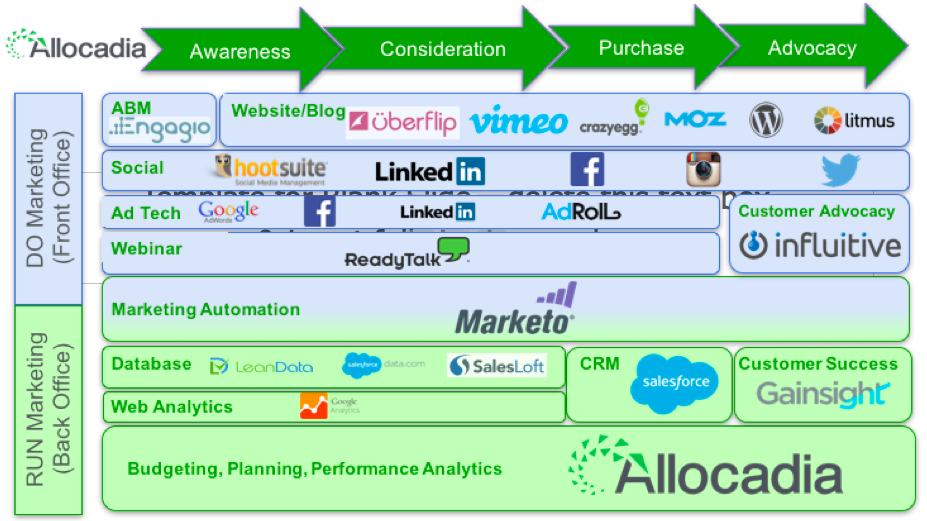
Martech Stack: Informatica
A software development company, Informatica, decided to present their digital tech stack from the perspective of their customer.
This marketing flow diagram illustrates how the data is stored and what marketingtech they are using for best marketing practices.
It is a unique approach, as it is not common to show the “you – customer” technique in Marketing Tech diagrams.
The diagram guides customers through different tech stack tools, showing them the way in which their data travels through companies martech stack.
A user-friendly approach that definitely caught our attention.

MarTech Stack: Microsoft
The globally-known company, Microsoft, showed their tech stack examples in 2017.
The processes in a marketing loop have been split into groups of pre-sales, sales, and post-sales marketing technology stack tools.
Their vision was to create a universal, automated version of tech stacks that can be used by anyone.
Moreover, many of the technologies used are Microsoft-owned, such as PowerBi or Skype for Business.
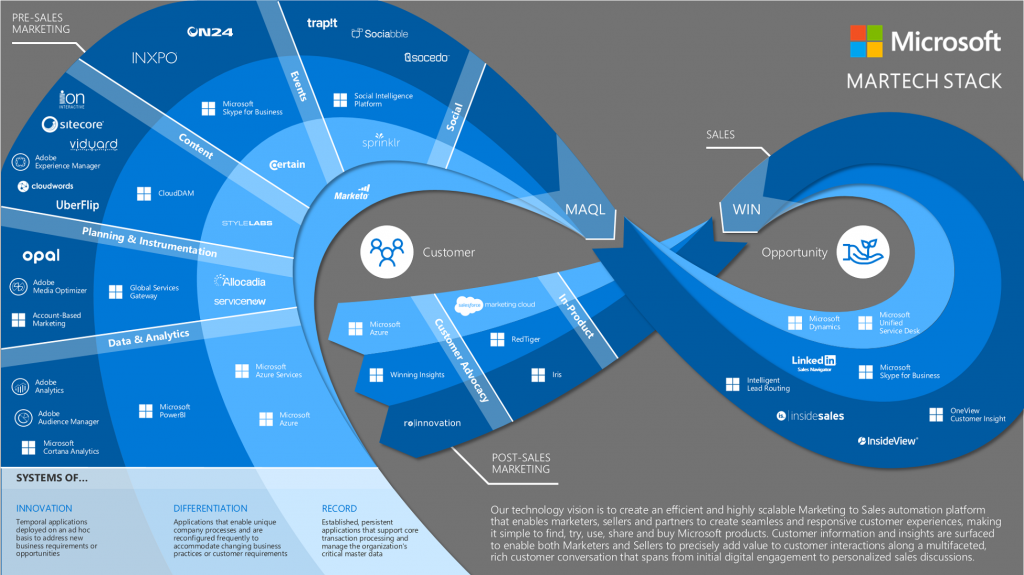
MarTech Stack Examples: Janus Henderson
This example of a martech stack diagram was the winner of the 2018 Stacks Awards.
After Janus Henderson Group merged, they utilized their marketing tools to their best benefit.
They have built out a 3-system diagram (Innovation, Differentiation, Record) characterized by a frequency of change as well as ideas.
Common things for the 3 systems are these 4 functions:
- Awareness
- Production
- Analysis
- Engagement
Among many tech stack tools, they are also using BrightTalk which helps with online webinars and video streaming.
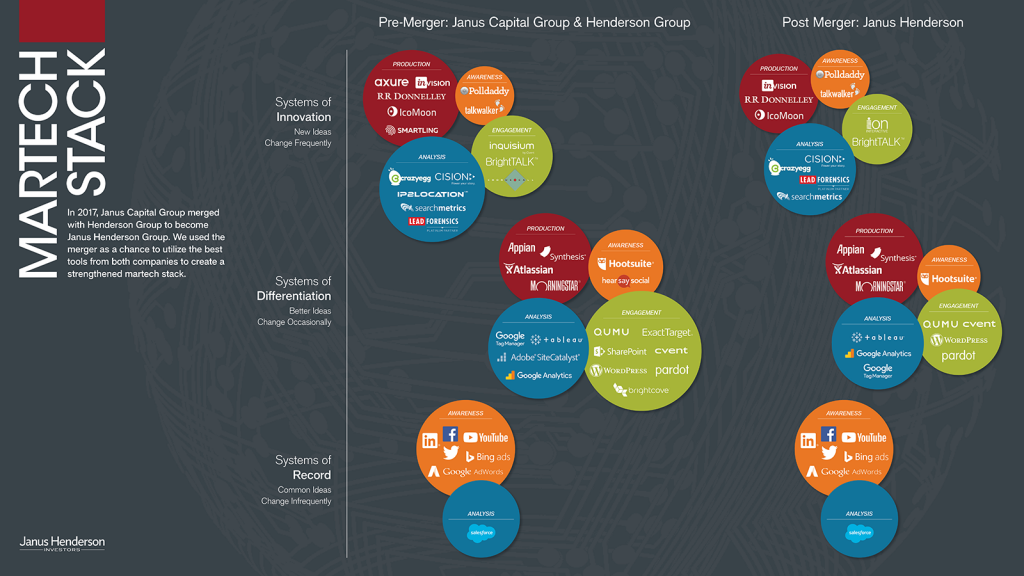
Marketing Technology Stack: Allocadia
In the 2017 example, Allocadia focused on mixing marketing and sales and finance into one marketing technology stack.
It was a unique approach that was honored among the other 57 tech-stack examples.
The loop shows how those two departments (named Run and Do marketing) are highly connected to a company and what tools comprise their martech stack.
Moreover, we can see that Run Marketing is done by Allocadia and Do Marketing by Marketo (a software company).
Finally, most of the tools are designed for only one function in the company, except for Salesforce which is used in both Run and Do Marketing.
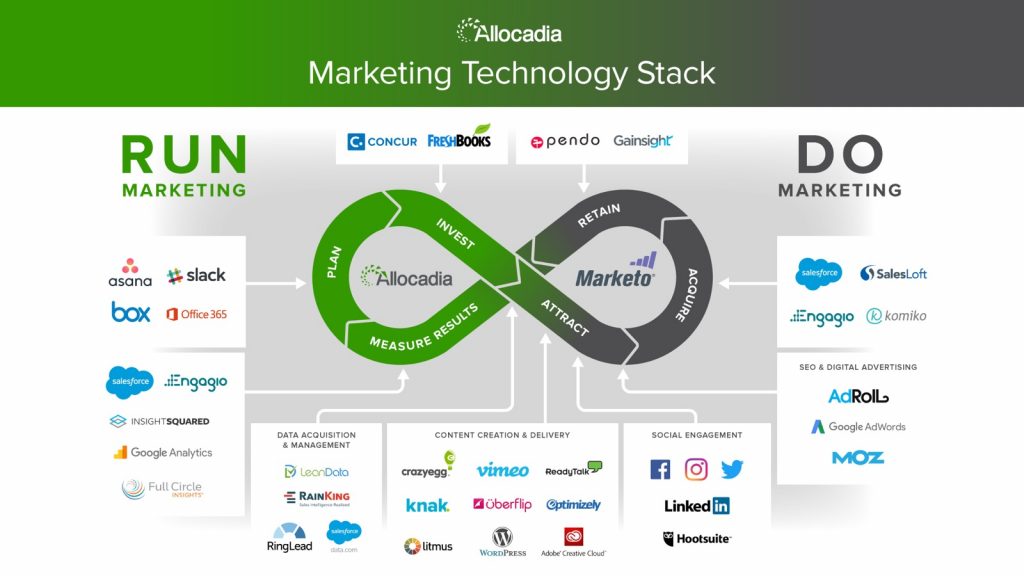
Marketing Tech Stack Examples: Aprimo
The digital asset management software, Aprimo, decided to visualize its digital marketing stack in a continuous loop.
The marketing cycle infographic is divided into 5 parts:
- Plan
- Spend
- Create
- Distribute
- Perform
Six circles of marketing tech stack are closing around the company itself.
It depicts the importance of every stage for Aprimo. The company, for example, uses Uberflip, Content Experience Platform (CEP) in a few stages.
SalesForce is also peppered all throughout the marketing tech stack infographic.
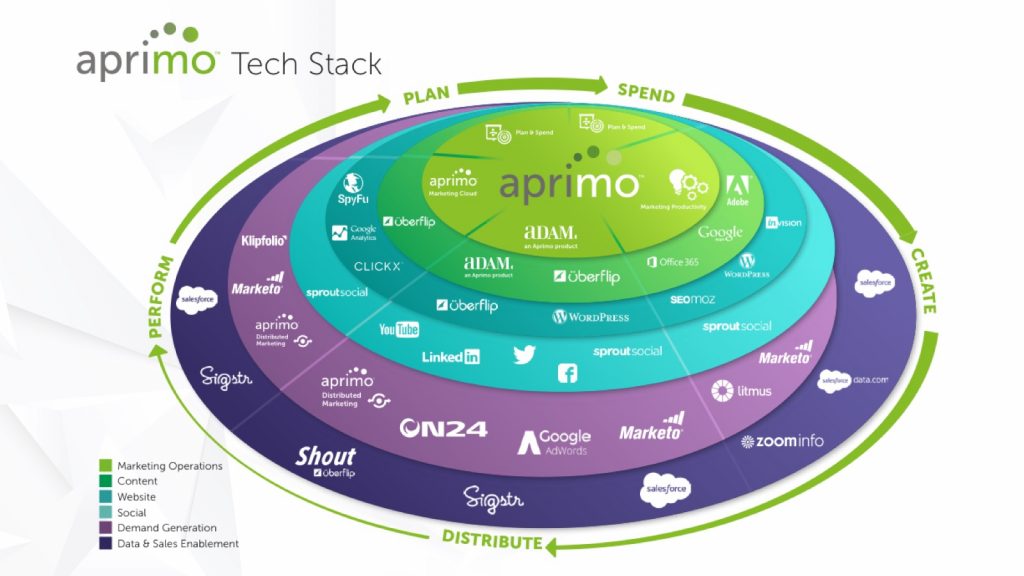
Related Article: AI in Social Media
Martech Stack of Digital Engagement: Cisco
Cisco’s marketing stacks from 2017 are prime examples of the importance of focusing on the customer journey.
Clearly, Cisco’s marketing technology stack is focused on engaging customers and reusing data into their solutions.
Other branches are partner, seller, and data and ops, which all together create a cohesive solution for this worldwide leader.
Furthermore, this stack was used as a baseline for the new one (showed above).
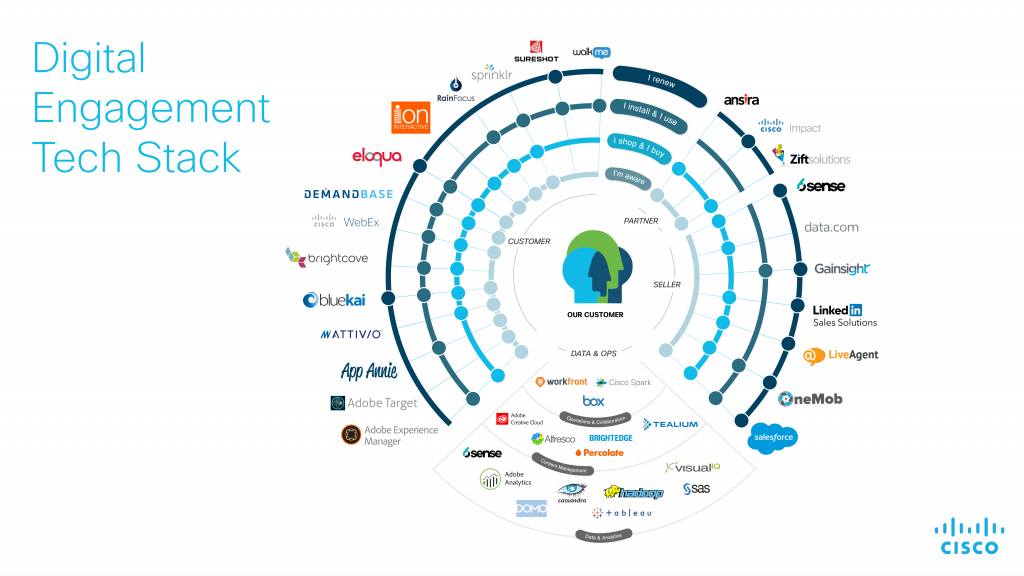
Martech Stack: Red Wing Shoes
Red Wing Shoes‘ martech stack is a perfect example of how e-commerce and brick and mortar business divides their processes into 3 main strategies:
- Personalization
- Productivity
- Ilumination of value
Red Wing Shoes integrated tools via a flexible marketing stack that are divided into two business concepts – B2B and B2C.
In addition, there is the shared sector across customer-facing parts of the organization.
On the front end, there are sales (business and consumer), meanwhile on the back end – operations and analytics.
One of the tools used is Silverpop, owned by IBM, a platform providing email marketing, lead management, and mobile engagement.
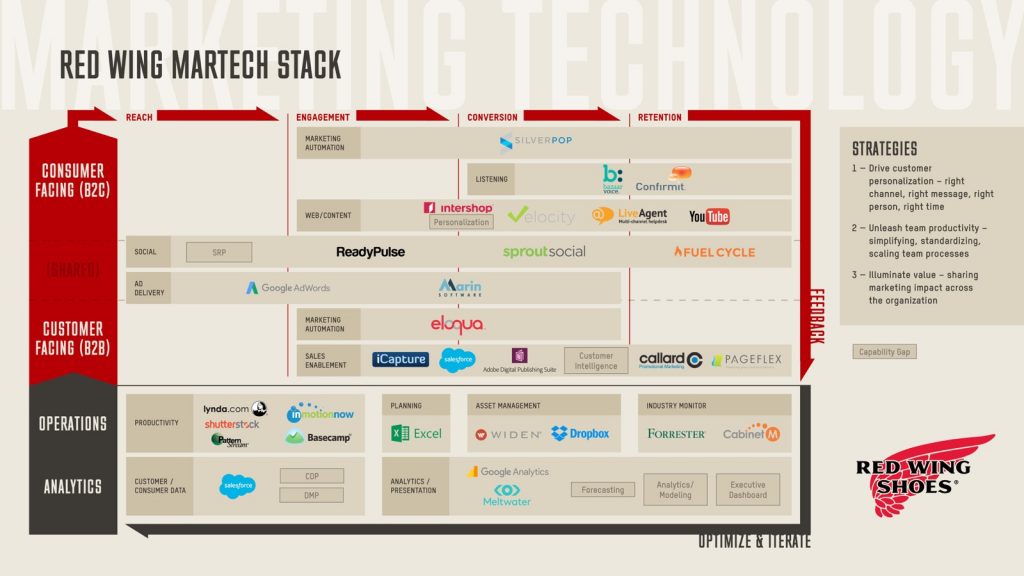
Martech Stack Examples: Acrolinx
In 2016, Acronolix won the Stack Awards with their visualization of marketing tech tools.
Their customer-centric diagram representing their tech stack focuses on 5C’s:
- Contacts
- Connections
- Content
- Customer Data
- Collaboration
The connections stage is divided into segments based on the purpose of the tools (social, site, email, interactive, remarketing). Likewise, the content stage is divided into content creation and content optimization and scoring.
It is interesting to mention that they do not include the Competition segment.
However, the CMO of this company claims that their product is unique enough to not consider other players.
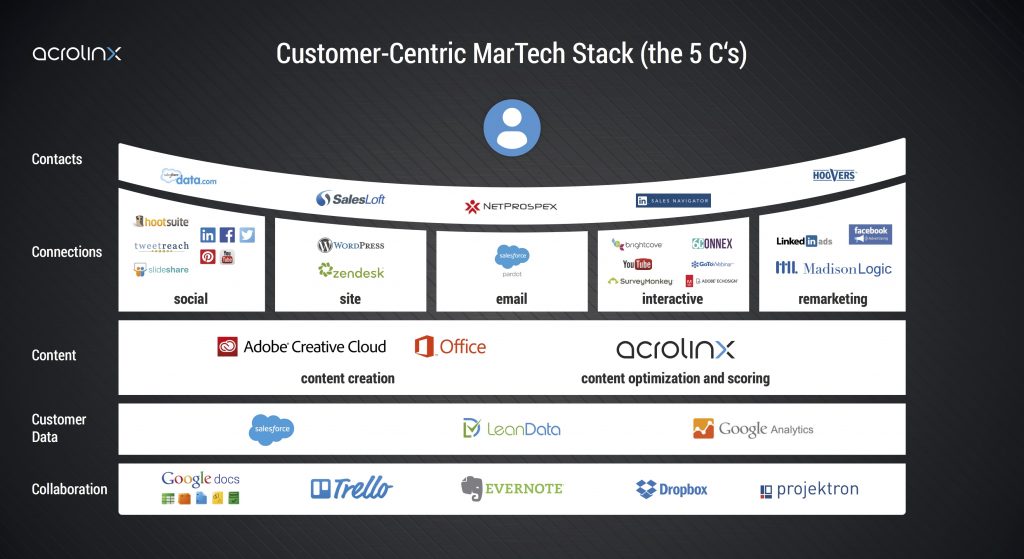
Marketing Technology Stack – Digital Change Agent Journey Map: Connective DX
The example of a “journey map” by Connective DX is created by two circles and an infinity line that intertwine with each other.
We have to admit, Influence, Engagement lines, and the 4 main pillars are unusual ways to depict 21 tech stacks of Connective DX.
However, the reader can easily follow which tools are used for which purpose and perhaps draw inspiration from this unusual marketing stack (see the bottom of the infographic).
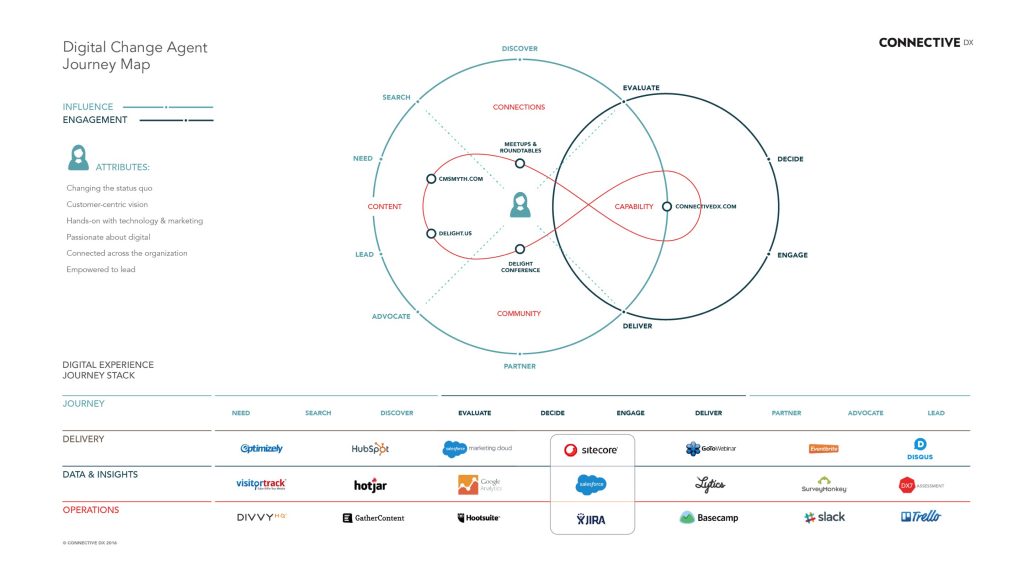
Marketing Technology Stack 2021: Delphic Digital
Delphic Digital, now known as Hero Digital, decided on 6 main categories of marketing:
- Acquisition
- Nurturing
- Retention
- Insights and analytics
- Communication
- Productivity
There are 32 technology platforms used in the different marketing stages – showed by dots in this marketing tech stack example.
This is a clear and simple way to show how platforms are cross-functional and which tools are best to use for the specific stage.
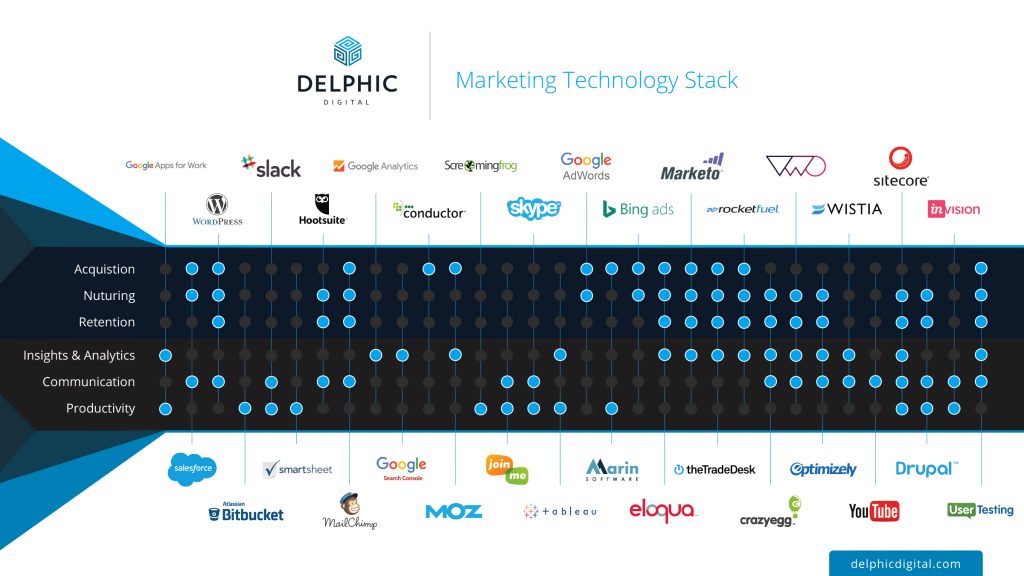
Digital Marketing Tech Stack: PitchBook
One of the winners of the 2016 Stacks Awards was Pitchbook, an investing company.
They used a marketing tech stack flowchart to represent their platforms, dividing them into 6 main dimensions.
There is a creation, collaboration, capturing, execution, and analysis.
Although at first glance the flowchart may seem a little confusing, it actually explains what are the best tech stack tools to use to get from one stage to another.
The main tool for the company’s automation is Marketo, a widely known software used by many martech companies.
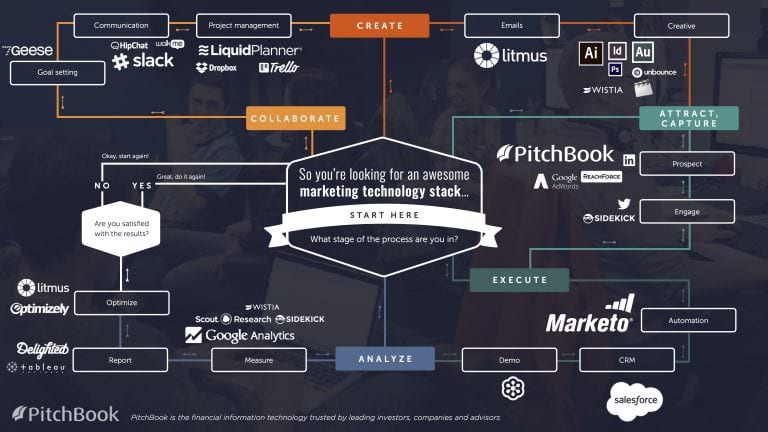
Marketing Tech Stack 2021: Uberflip
A content marketing platform, Uberflip, presented their tech stacks in a form of the customer journey.
In addition, this example of a technology stack breaks up tools into 4 pillars that combined promise sales and customer success:
- Creation
- Experience
- Distribution
- Insights
Moreover, the tech stacks can be looked at from the content side or demand generation side. Combining these different perspectives and creating an easy-to-navigate tech stack resulted in winning the Award in 2015.
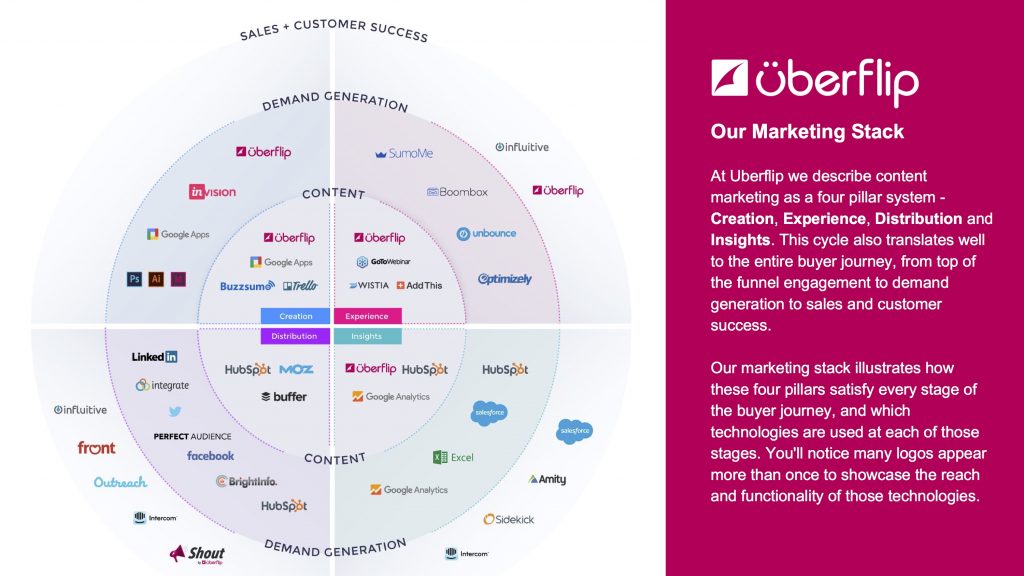
Marketing Stack 2021: Datapipe
Presenting data flow in the form of the funnel was a solution provided by Datapipe, known now as Rackspace. They asked the question “How this tech stack helps us gain customers?” Hence, the birth of their marketing tech stack infographic.
The diagram shows different aspects of marketing such as email marketing, lead conversion, nurturing, and deal conversion and which technology solution they are using for each.
They decided to use mainly the Salesforce tool, as this integrated CRM platform helps with the connection between customer and producer.
Nevertheless, they also go with SEO tool Moz, WordPress, and other useful tech stack tools.
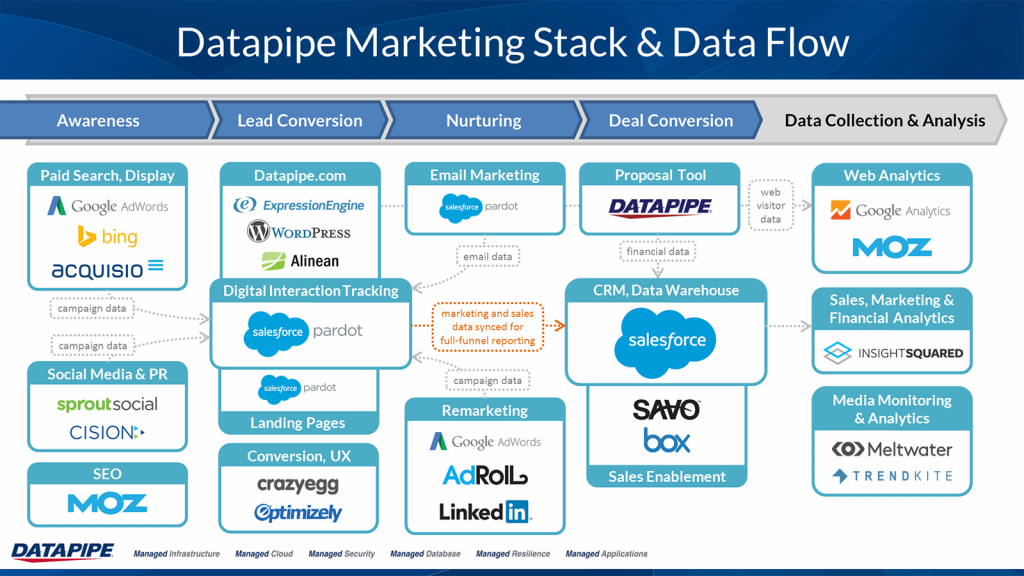
Martech stack of Software Implementation: IntelligenceBank
Intelligence Bank’s circuit marketing stach board depicts how interconnected and intertwined all platforms are in the marketing department.
CRM and CMS have the most wires which shows the importance of those two segments for this digital asset management company.
What’s more, each tool or a group of tools has an explanation, therefore, we can see that Stripe is used for payments, New Relic for server and website monitoring, etc.
Finally, Google Alerts is an addition acting as a PR distribution software and contributes to making a difference in the company’s operations.
This marketing technology stack definitely has something to offer to many companies!
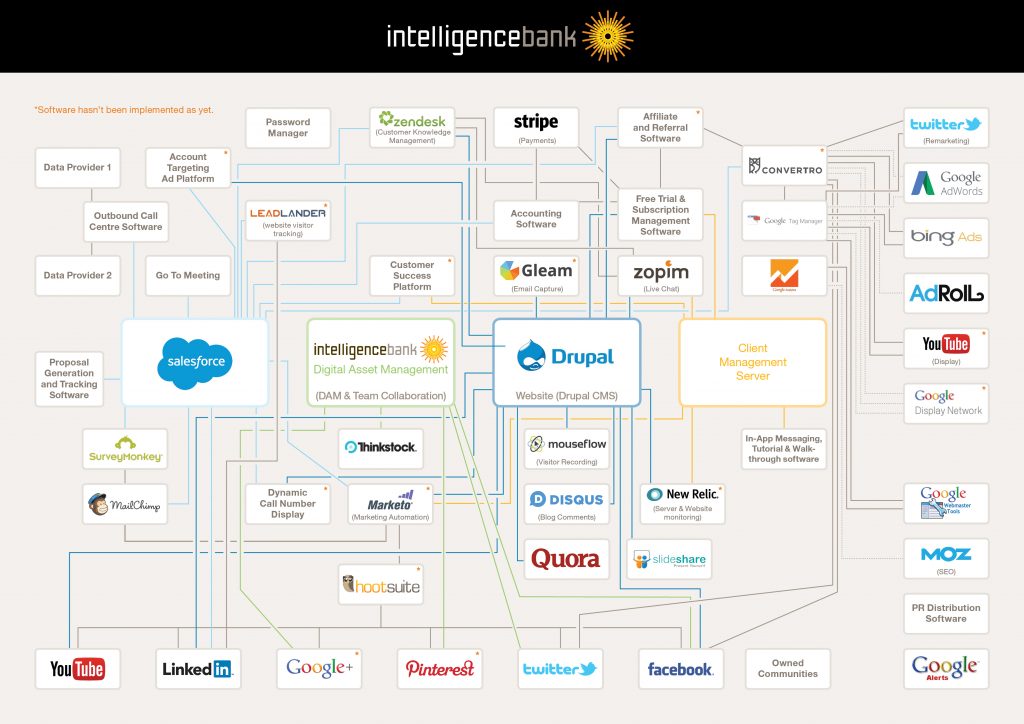
Marketing Tech Stack 2021: John Wiley & Sons
If you thought that only certain industries oopt for technology stacks, the next example will prove you wrong.
Education services, Wiley, has also created a martech stack which they use for:
- Lead Generation
- Marketing Automation
- Social
- Sales Automation
- Voice of Customer
- Web Analytics
- Insights
To make it easier, they also added the arrows connecting the tools and showing which ones are automated and manual.
Therefore, all new tech stack users can evaluate which tools they would like to add to their stack and determine how much time they would like to spend on using them.
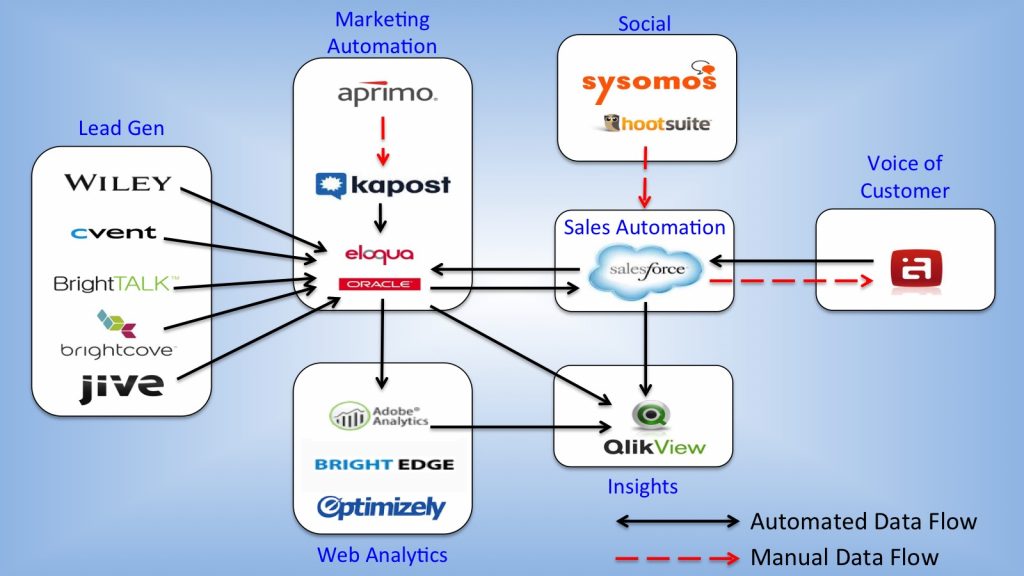
Visualization of Marketing Tools: The SMACs stack
The SMACs stack is one of the well-known tech stacks as it is extremely cost-efficient and easy to navigate. The concept is based on social interaction, mobility, and analytics.
This easy to follow marketing tech stack is separated into 4 main categories:
- Attract
- Convert
- Measure
- Nurture
Each of these categories consists of useful tools some of which are grouped together, which allows users to see which tools work well with each other and further contribute to company’s improvement.
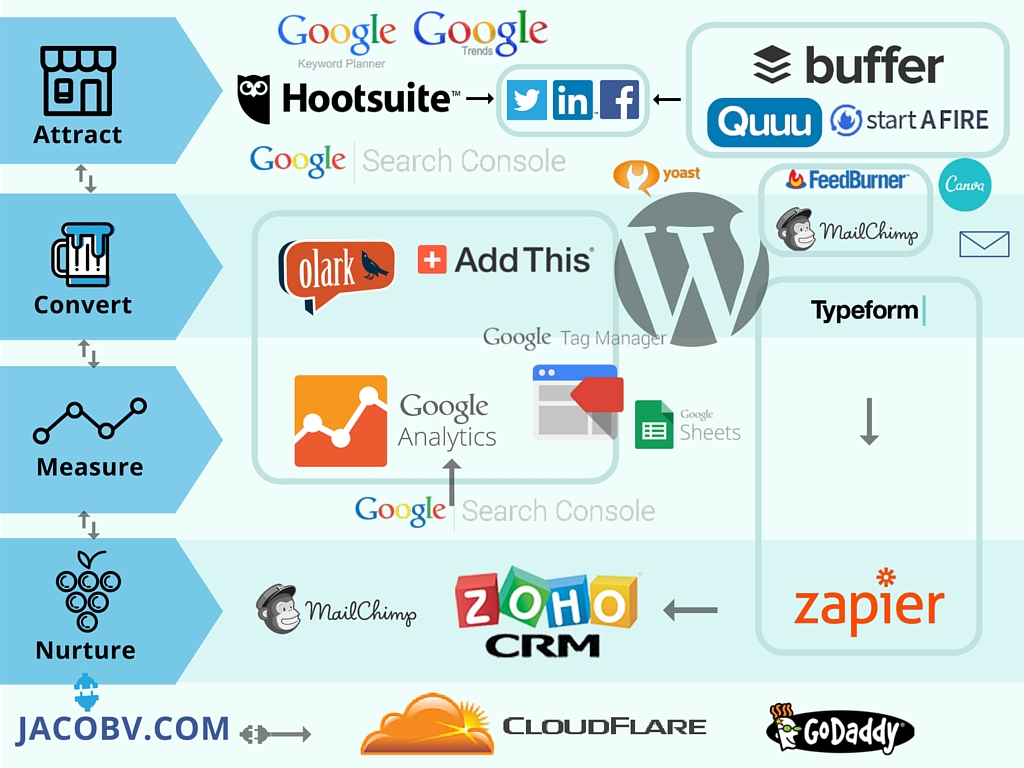
The Lead Generation Technology Stack: TechnologyAdvice
As it’s name suggests, lead generation is focal for TechnologyAdvice Stack. The tools used in their martech stack are divided into five main phases awith subsections. These pahses are:
- Content
- Awareness / Promotion
- Lead Capture
- Lead Management
- Analytics
Technology advice use popular and more “one-size-fits-all” tools, as well as the “niche” ones. Hence, you can see tools such as Hootsuite, Buffer, and Crazyegg, as well as Drupal, SugarCRM and others.
As a result, the lead generation technology stack gives us a good variety to choose from.

Martech Example – European VC Tech Stack: VC Cafe
European VC Tech Stack made by VC Cafe is a universal diagram for any company.
It contains all crucial platforms for conducting business.
Therefore, having many platforms in each category gives an interested user a wide range of tools to check out and choose from.
VC’s tech stack board is divided into 8 groups including:
- Dealflow Management
- Portfolio Management / Cap tables
- Communication internal / external
- CRM
- Research
- Board management / Recruiting / Ops
- Scheduling / Assistants
- Exit Related
Many of the tools are widely known around the technical marketing experts and novices alike – such as Calendly, Google Drive, Slack, LinkedIn, etc.

Marketing Funnel and Tools: Seismic
Seismic is a SaaS company known for helping other companies with sales enablement and delivering outstanding customer experiences. Their worldwide success proves that their martech stack works and is worth checking out.
They present their marketing tech stack as a five-step customer journey consisting of the following phases:
- Attract
- Engage
- Nurture
- Convert
- Analyze & Optimize
Moreover, it focuses on measuring sign-ins and content requests. Measuring clicks, impressions, and click-through rates gives more tracking to prove growth and engagement.
Lastly, they included notes of what the company action is in each phase. Quite useful, wouldn’t you agree?

Marketing Stack: Lattice Engines
Lattice Engines’ Marketing Stack is concise and simple to view. It consists of five categories:
- Lead Management
- Anlytics and Reporting
- Data and Programs
- Content and Social
- Sales Enablement
Each category has the relevant tools listed, which makes it extremely easy to navigate and choose from.
This kind of tech stack is typical for marketing technology companies. So, if you are the owner of one, make sure to check this stack out!
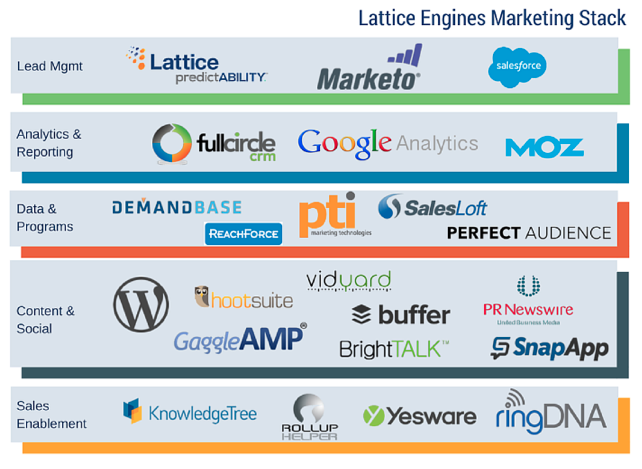
MarkCom Technology Stack: Acquia
Digital Experience Platform, Acquia, has a simple clean layout of their martech stacks.
A pyramid structure demonstrates marketing tech that starts with team collaboration and goes on to:
- Prospecting
- Website
- Inbound Marketing
- Analytics
This tech stack example is a blend of growth hacking tools for improvement of crucial aspects of company’s smooth running, focusing on the correlation between marketing and sales.
Worth mentioning is that Acquia uses Asana software for team collaboration and work management, which makes project and team management processes much easier.
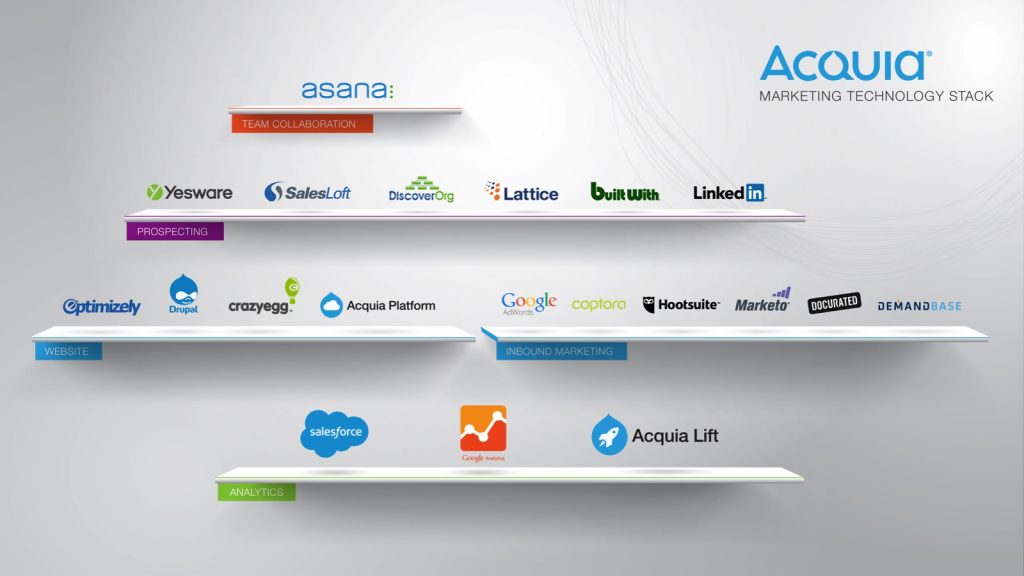
Marketing Tech Stack 2021: Terminus
An account-based marketing researcher does not need a lot of platforms to execute marketing. Terminus is one good example of this.
This account-based marketing platform has created a technology stack that focuses mainly on blog features as well as landing pages, CRM, marketing automation, etc.
Some of the tools they use include Canva, Buffer, CoScjedule, and others.
Based on this martech stack, it is noticeable that the company is mainly focusing on traffic and lead generation.
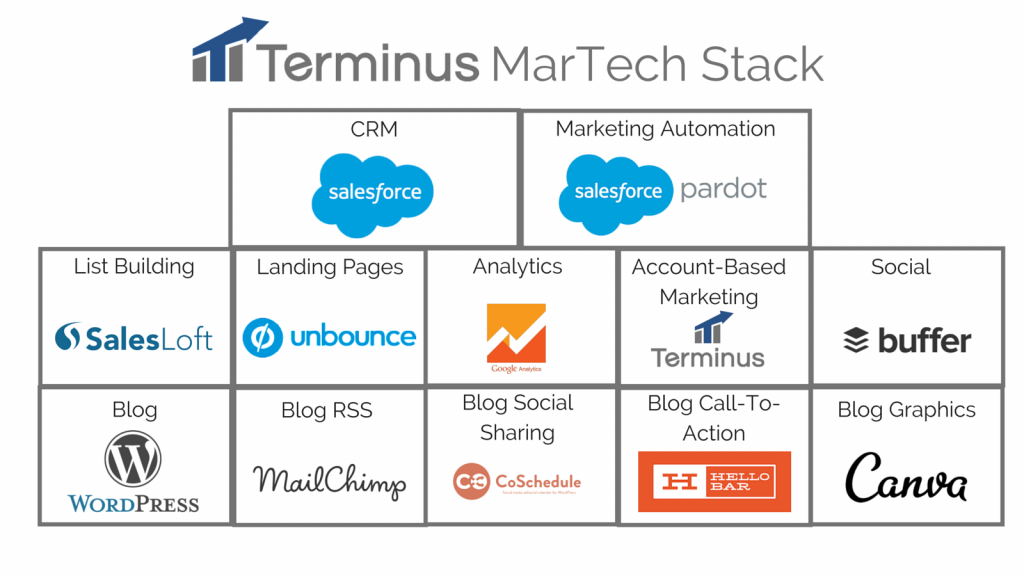
Marketing Tech Stack Tools in Funnel: Calero
Calero, a B2B company providing customers with technology expense management solutions, presented their technology stack in the form of a marketing sales funnel.
The martech stack diagram shows internal marketing processes which allow this company to land customers, leading to their revenue stream.
Their funnel tech stack has three main stages:
- Target Accounts and Contacts
- Promotion and Engagement
- Acceleration
Furthermore, the funnel is split into six stages representing the customer journey and the tools needed for each step of the process.
One of their interesting tools is Bombara which focuses on getting insights when the B2B customers are actively on the market.
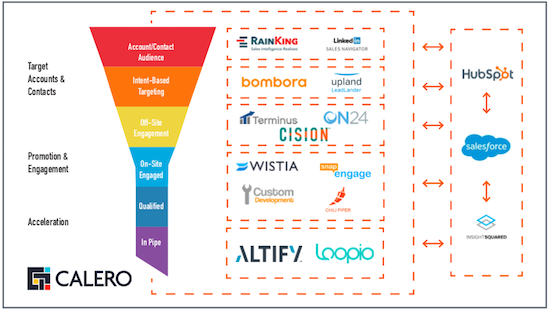
Marketing Technology Stack Example: Absolutdata
Custom AI platform, Absolutdata, shows an advanced and technologically-oriented marketing stack. It is divided into five segments which together contribute to scalablility and smoothness of business running. The segments are:
- Front-end technologies
- Data processing and analytics
- Third party software integration
- Framework, languages, and webservers
- Cloud services and data storage
The infographic of marketing tech tools depicts the integration of all data sources.
This technology-oriented company chose tools that are not that popular but still serve the purpose, especially for advanced actions.
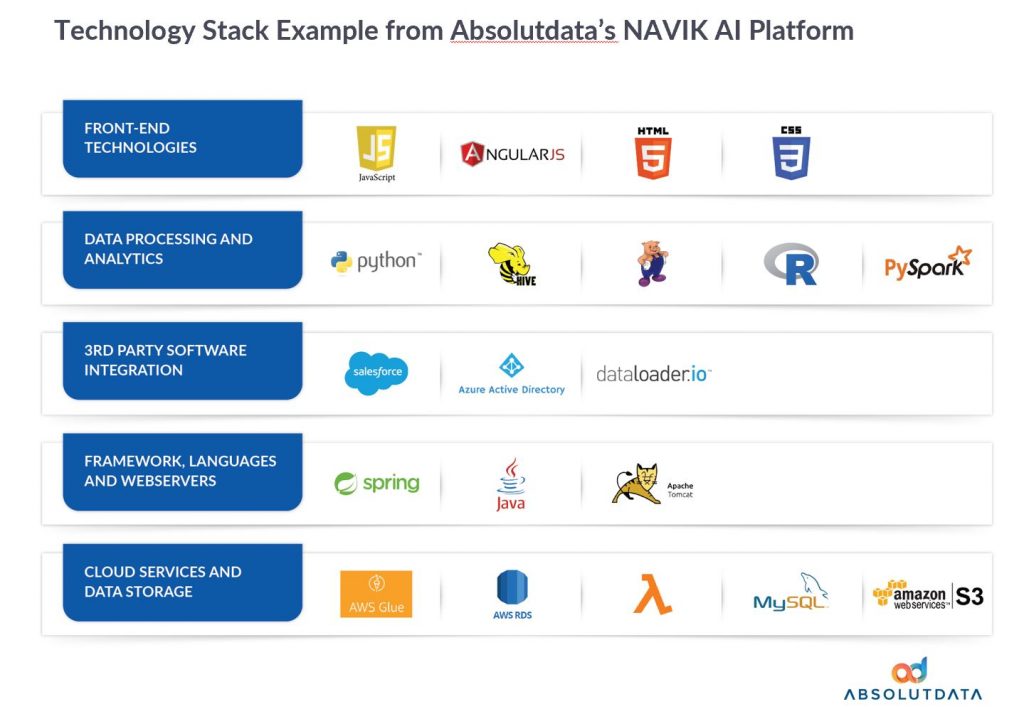
Marketing Funnel And Tools: Hive
Hive is a project management platform that helps users stay on top of their projects at all times.
They have created a marketing stack that focuses mostly on integration and automation.
Very detailed segmentation allows the reader to follow which platform is used for which stage of the marketing process. The tech stack is divided into five main stages:
- Awareness
- Consideration & Conversion
- Engagement
- Collaboration
- Data and Analytics
Moreover, their own platform allows collaboration and a general overview of all technologies they are using, which makes everything so much easier.

Marketing Technology Stack: Cramer
Cramer is a marketing agency with a focus on events. Their technology stack shows which tools can be used for six different business processes.
The company has also included tools used for infrastructure, which is an exception from many other martech stack examples. The tools they use for this stage are:
- Fonts.com – offering more than 150000 different font styles
- Medium – a place for writing, reading, and researching about different topics
- Twilio – cloud communication platform
- Webhok CMS – a website builder platform
This marketing tools infographic gives an answer and solution to key problems – content, sales enablement, and social amplification. Moreover, there’s a really cool mix of well-known and small start-up tools.
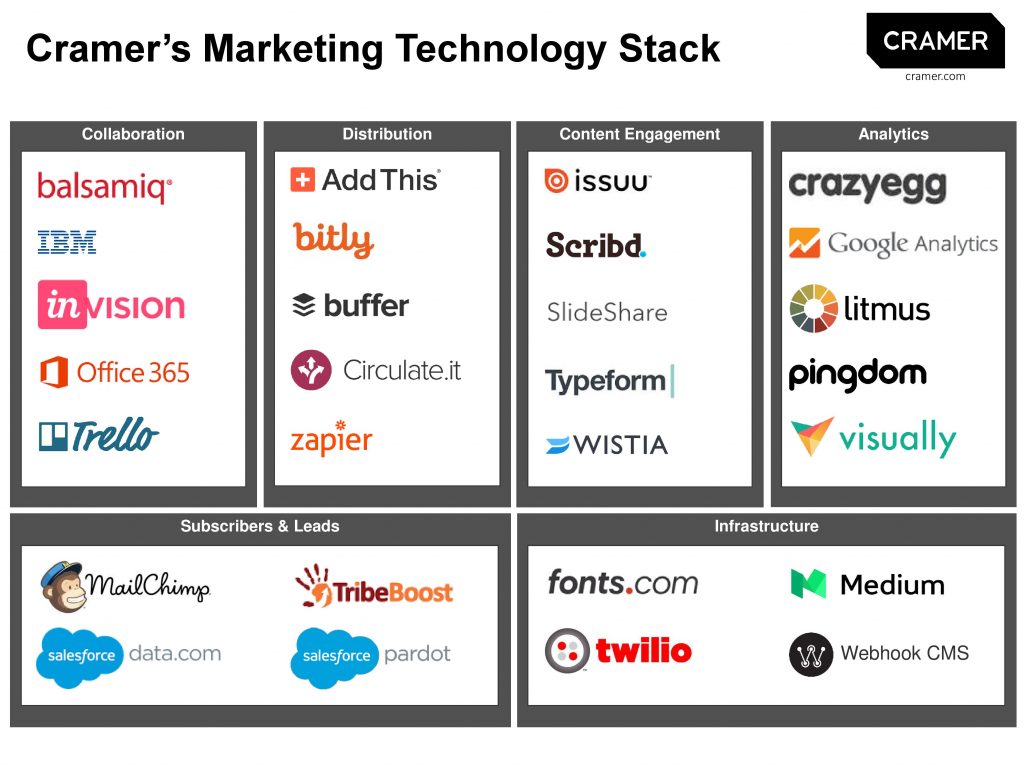
Marketing Stack Automation Flow: CBInsigts
CBInsights helps customers find new business opportunities and trends. Their digital tech stack diagram is displayed as a flow chart and shows marketing stack automation, which allows a more efficient marketing.
The 6 steps to success are the following marketing channels:
- Landing pages
- Re-targeting
- Activation emails
- Automated drip marketing
- Product Demos
CBInsights shows a simpler and smaller range of marketing tools two of which they use specifically for email marketing – SendGrid and Mailchimp.

Martech Stack for Data Integrations and Automation Stack: Merkle
The data-driven company, Merkle, illustrated their approach to martech stacks by displaying areas of the brain and how the tools are related to them. There are five main areas:
- Insights
- Activation
- Orchestration
- Integration
- Data Management
Each marketing function of the tech stack infographic is divided into subsections.
Overall, the layout helps visualize which marketing tools make up the different parts of the marketing process and what specific aspects of marketing they can be implemented for.
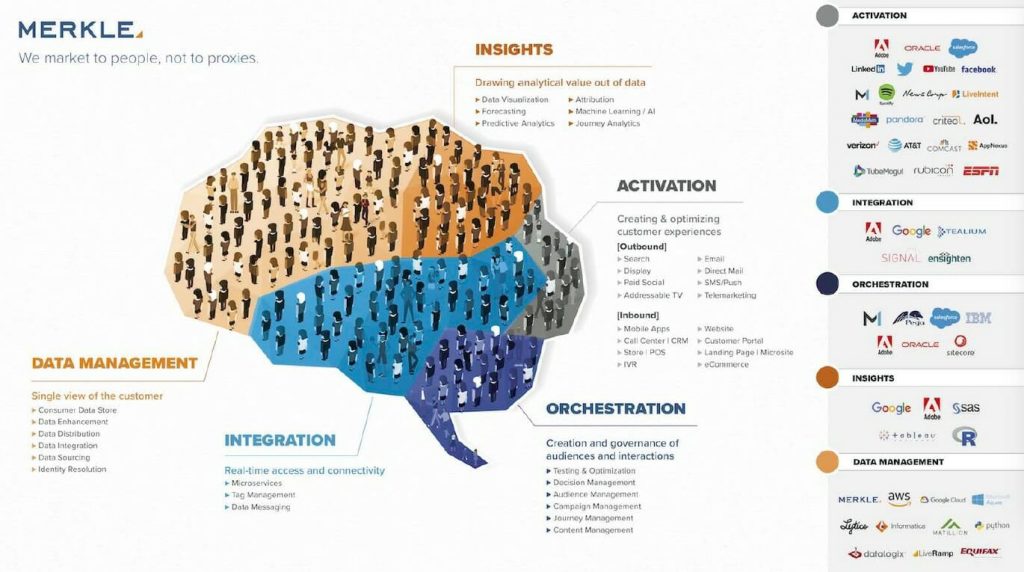
Marketing Tech Stack Infographic: Tennant
Tennant is an American-based cleaning company that creatively presented their martech stack as one of its products: a floor-cleaning machine.
The loop revolves around the main themes:
- Attraction
- Engagement
- Collaboration
- Revision and revive
Subsequently, four main marketing stages are then divided into subcategories, which are simple and easy-to-understand for the user.

Marketing Tech Stack 2021: Kurtosys
Kurtosys is a digital experience platform for the asset management industry. They have used five key stages of customer journey to represent their tech stack solutions.
Next to each stage there is a short explanation of how they implement different tools for the best results. They included icons of tools for each stage, plus the secure stage which is located in the middle.
The company shows that some tools have multiple purposes and can be used in different stages such as Salesforce, DocSend, etc.
Many martech stack infographics show the advanced approach to their marketing and Kurtosys is definitely one of them.

MarTech Stack + Intelligent Customer Journey: Mobly
Mobly is a furniture stores company that created their marketing tech stack example in the form of a customer journey represented by a man driving a car.
Marketing tech solutions are divided into 4 different segments:
- Systems of Engagement
- Intelligence Systems
- Systems of Record
- Marketing Operations
Each segment has different tools lined up which makes this infographic easy to follow and understand how to best use different tools.
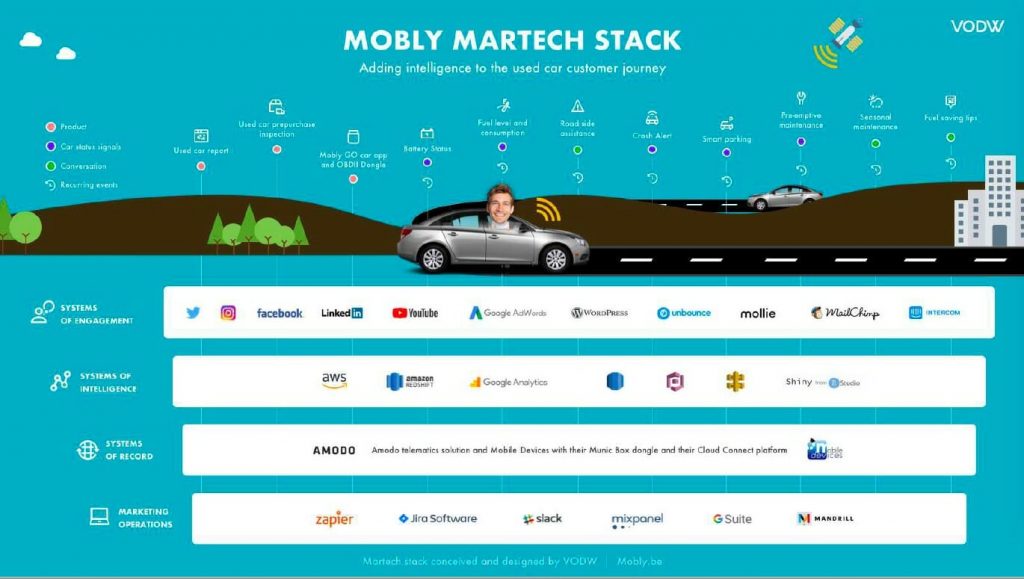
Marketing Tech Stack 2021: Marketing Masala
Marketing Masala, an Indian-based company providing digital marketing services, suggests that the marketing department should focus more on their growth.
The digital tech stack diagram represents 21 growth-hacking marketing technology stacks.
In the diagram below, the tools implemented work to:
- Qualify leads
- Boost content marketing
- Ceate landing pages
- Improve SEO
- Help with customer engagement
This simplistic way of showing which tools are best to use for growth hacking together with their features is a great resource for both new growth hackers and the ones looking for some inspiration.
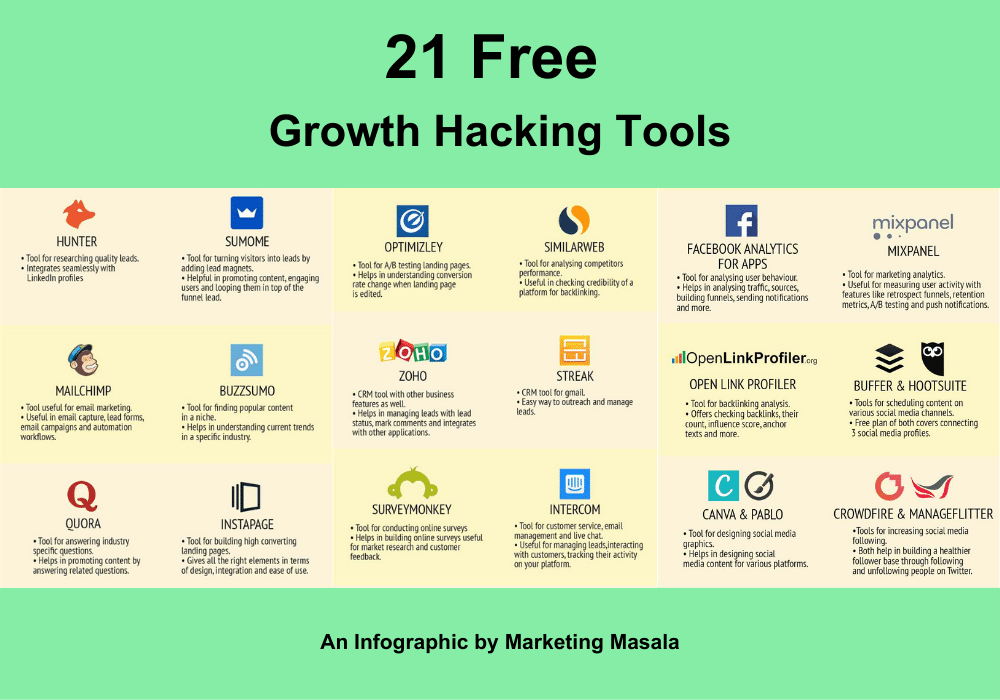
The Sales Tech Stack 3.0: Clemmons.io
Clemmens.io is a B2B lead generation and growth marketing agency that has developed a sales tech stack focused on the sales funnel.
Their sales stack is divides into four stages:
- Analytics and sales intelligence
- Research and prospecting
- Messaging and outreach
- Deal pipeline and CRM
The sales process is then divided into steps that help potential customers go down the funnel and the right tools to ensure their conversion.
The marketing tools flowchart below shows the company’s detailed approach to getting customers.

Marketing Tech Stack: Effin Amazing
The “less is more” approach by Effin Amazing keeps it simple, to the point, and proves its effectiveness. Only six marketing tools are included in their 2020 tech stack:
- Google Tag Manager
- Segment
- Clearbit
- Autopilot
- SAlesforce
- Amplitude
Simplicity can be a thing of beauty when trying to avoid Stackpocalypse – a land where many companies lose their direction.
Effin Amazing believes that having a variety of choices of tools does not imply every company should opt for them or that it is the best choice.
As a result, their digital marketing tech stacks integrate together seamlessly.
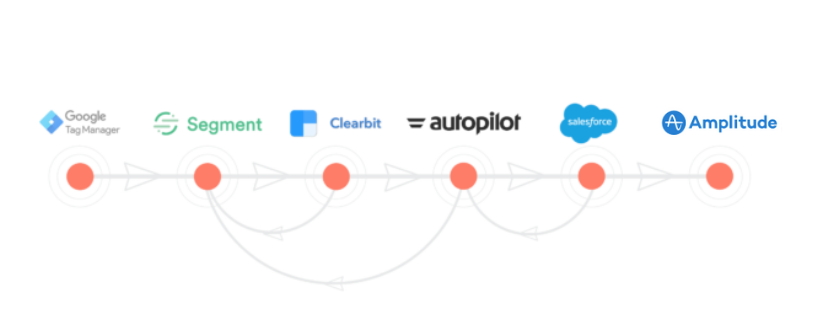
Martech Stack Examples: Zero Dollar
Free technology to conduct growth marketing was put into simplistic graphics and is also the new approach of Zero Dollar. The nine categories with different tools that they included into their martech stack are common for every business:
- Attribution
- Push notifications
- Crash analytics
- App analytics
- Referrals
- A/B testing / In-app engagement
- Tag management
- ASO
- Customer service
This marketing tech stack can be a perfect solution for bootstrapped start-ups.
Interestingly, in order to support their customers, they opted for osTicket software – a single marketing tool that combines email, website, and phone calls inquiries.

Marketing Flex / Org Stack: Reduxio
Reduxio’s diagram is one of the most elaborate and detailed ones.
It consists of three main circles that make up the marketing tools graphic with the following focus areas:
- Product and Design
- Sales “Wow”
- Growth Marketing
The color-coded dots around the main circle represent the responsibilities of each team member. Inside of the main circle, we can see different aspects of each stage, making it easy to follow and keep track of different marketing processes.
Moreover, they added a map of the world which shows where they are currently operating.
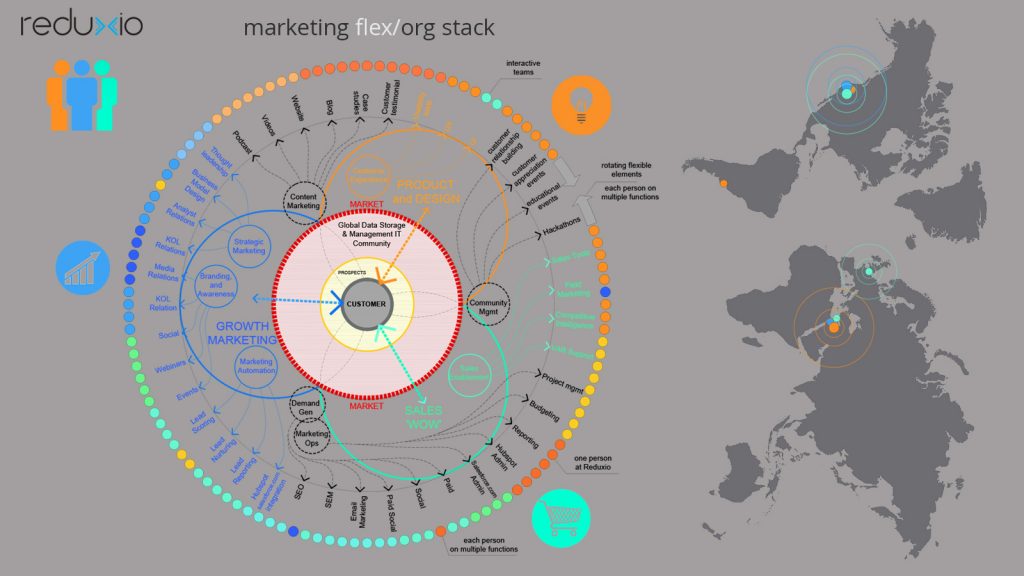
Marketing Tech Stack 2021: Tomas Capponi
The Growth Marketing Tools Funnel made by Tomas Capponi depicts the customer lifecycle and the digital software tools used in each stage.
This traditional funnel tech stack example incorporates various tools for different stages, including Hubspot, AdRoll, Funnelytics, and many others.
It is a nice representation of different tools and how and when they should be used to ensure a smooth customer journey down the funnel.
Hopefully, the end result will be a converted customer and increased revenue!

Martech stack: Everbird
An example of how agile teams and stakeholders experience rapid growth was presented on Everbird’s tech stack infographic.
Unlike other tech stack examples, they chose to focus on three main objectives: analysis, test, and growth itself.
Everbird categorized their martech stack tools into eleven categories that can help companies with instrumentation, reporting, testing, and optimization of their web and mobile applications.
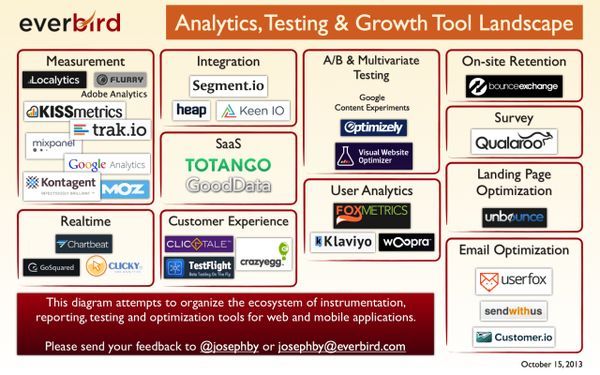
Digital Marketing Tech Stack: AdsMarketing
Italian marketing agency Ads Marketing decided to invert the well-known marketing funnel in order to improve ROI and their growth.
Most of the tools listed in the digital tech stack are a popular choice in marketing circles. The tools are categorized into eight different groups:
- SEO / Social Media
- Landing Page Optimization
- Content Marketing
- Website Optimization
- Email Marketing
- Conversion
- Customer Experience
- Social Media Optimization
Ads Marketing chose to stay simple and use only a limited range of tools which makes it easy for everyone in the company to use them and have control of various processes.
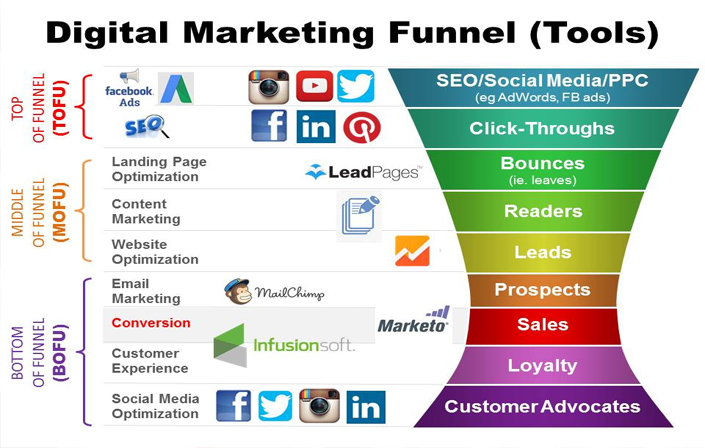
Marketing Tech Stack: Jackson Marketing
Jackson Marketing is a company that provides marketing and event solutions.
This agency decided to connect blocks so as to visualize the marketing processes with the corresponding digital tools underneath.
In each segment, the reader can find different platforms used for a smoother transition of the potential customers down the marketing funnel.
At first, it looks like they are using a lot of different tools. However, when you look closer, most of the digital tech stack tools are the same in every step – which is the way of cutting costs and simplifying the process.
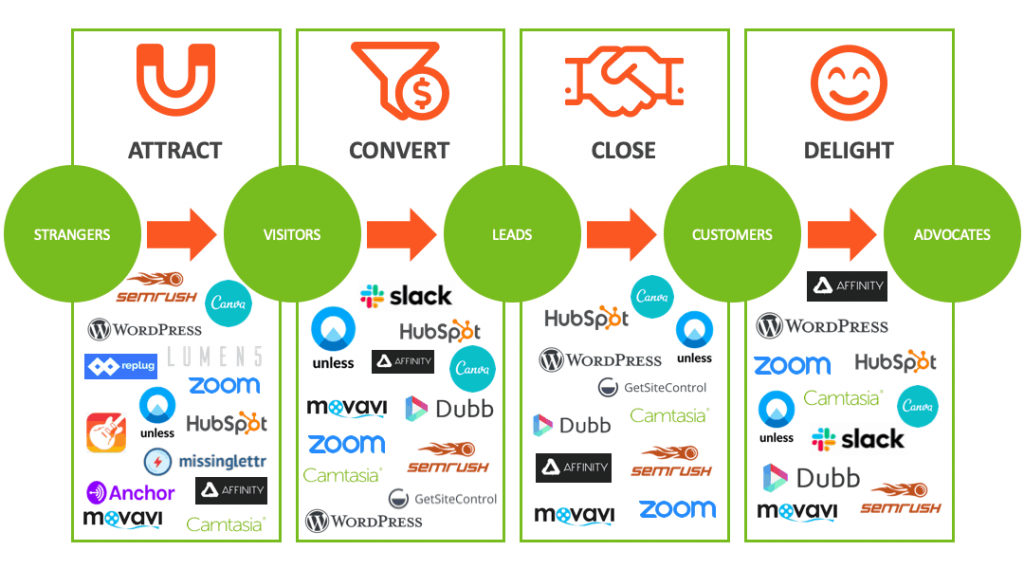
Marketing Stack: Invoca
As Invoca decided to switch to ABM (account-based marketing) strategy, they needed to change their account-based marketing tools.
Hence, the next marketing technology stack example! The tech stack infographic involves the ideal target customers and then subsequently five stages that evolve from it:
- Identify
- Expand
- Engage
- Advocate
- Measure
There is a clear understanding of the usage of platforms thanks to this untraditional marketing funnel.
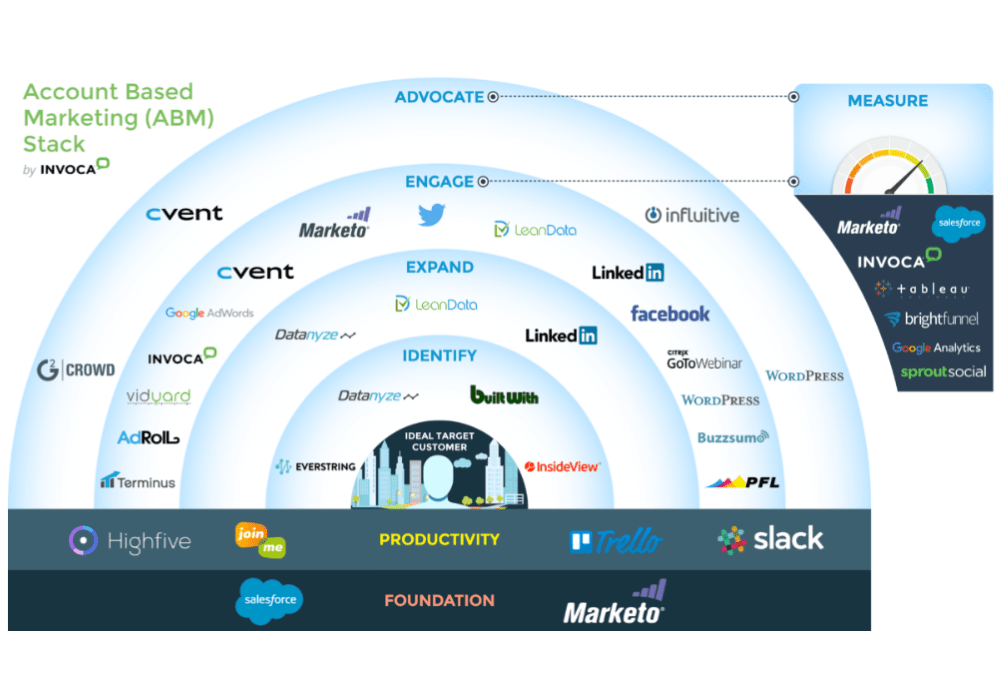
Marketing Tech Stack 2021: LeadMD
Similar to Invoca, there is another company that uses ABM (account-based marketing) – LeadMD.
They created a marketing tools infographic showing what is the use of each marketing tool, thus, making a clean and easy-to-follow martech stack example.
The four main tools LeadMD uses are LeadMD, Salesforce, Marketo, and Kapost.
Moreover, other tools are listed out based on how they fit into fourteen main categories, providing users with additional top-to-bottom funnel support.

Marketing Technology Tools: Bloomreach
Bloomreach is a digital experience platform purpose-built for e-commerce that helps companies to ensure smooth customer journey.
Their tech stack example is on the simpler side, focusing on three main stages and few extremely effective marketing tools. The three stages included in this martech stack example are:
- Platform
- Optimization
- Application
Each of the 10 tech stack tools has its purpose in the company’s running. Besides the well-known tools, there are a few not often seen in other marketing stack examples such as Tableau, Clearside, Selligy, and others.

Martech Stack: Ion Interactive
A content marketing solution platform – Ion Interactive has been a go-to for many content creators looking to attract, convert, and retain their audience.
To match their brand image, this company decided on presenting their marketing tools as an interactive marketing technology stack.
As a result, their tech stack infographic consists of six circles each representing a stage of the company’s interaction with customers (attract, educate, match, package, transact, advocacy). From there, each stage breaks into the platforms they are using on a daily basis.
Finally, a yellow arrow suggests that these processes are automated and can be reused regularly.
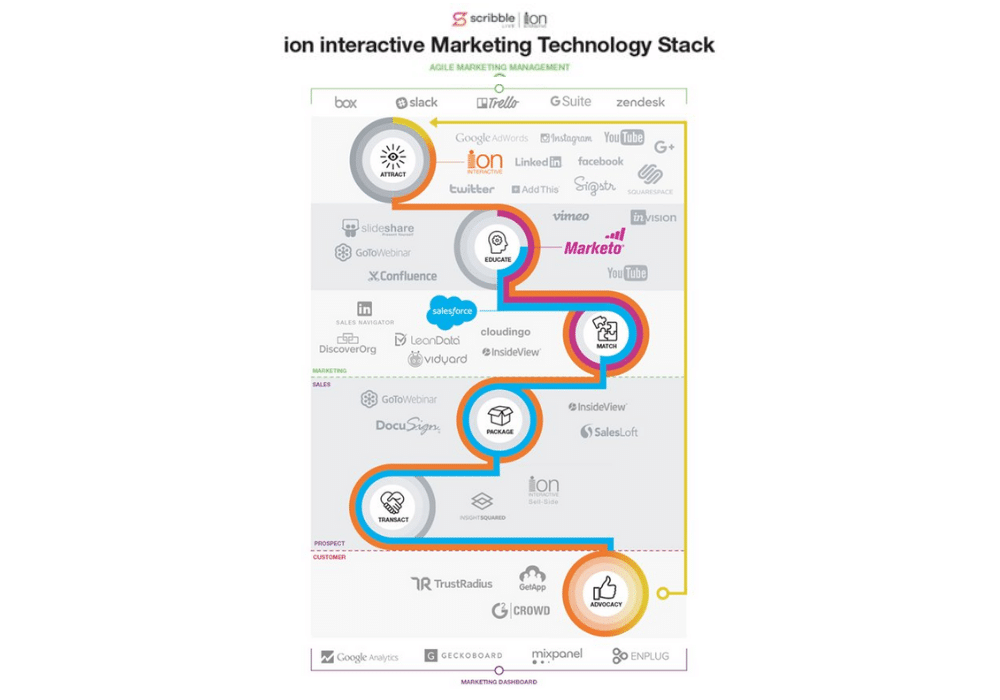
Marketing Technology Stack Infographic: Venture Scanner
Venture Scanner decided to show the marketing technology they are currently using. In order to choose the right platforms, they checked 900 companies and drew ideas from their tech stack examples.
The division into 13 main categories of marketing helps the reader to navigate and find needed marketing technology tools.
Some of the interesting categories, Venture Scanner has included are:
- Mobile Marketing
- Advertising Networks
- Influencer Marketing
- Web Personalization
This tech stack example leaves nothing to be desired as it provides a wide range of tools and platforms for different marketing aspects.
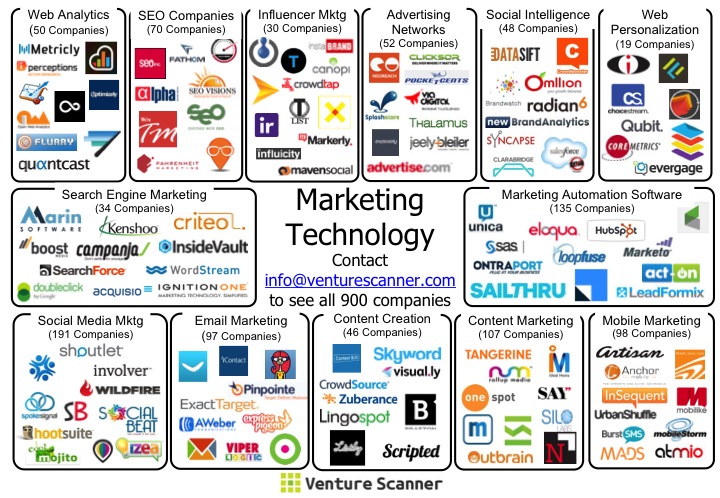
Marketing Tools stack: DemandBase
DemandBase is an ABM software that helps customers drive revenue and increase retention.
A starting point of their tech stack infographic is their software. The martech stack example contains the buyer’s journey with the addition of six pillars of account-based marketing:
- Web Experience
- Analytics
- Content Marketing
- Sales Enablement
- CRM (Client Retention Management)
- MAS (Marketing Automation Software)
Moreover, the platforms DemandBase uses are aligned around the stages of the customer journey providing users with an easy-to-follow overview of the most effective tools for each given stage.
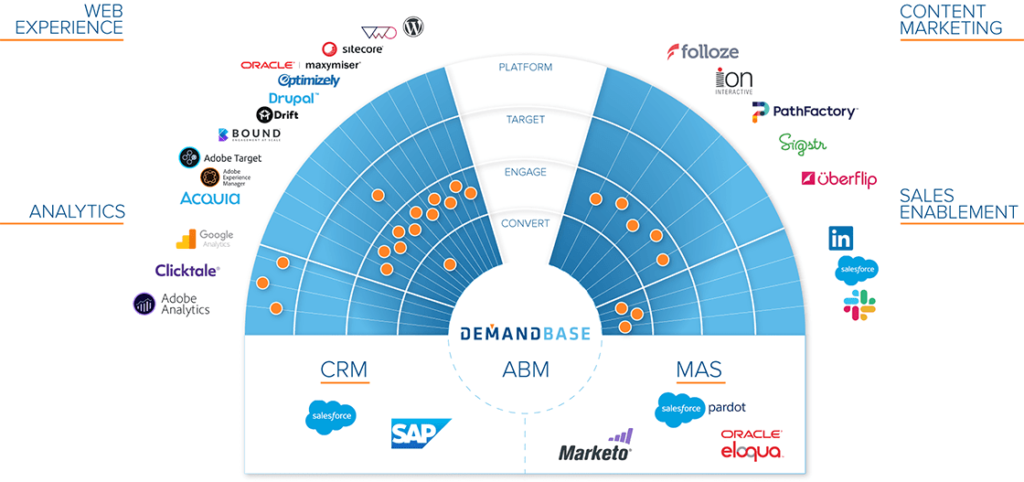
MarTech Automation Tools: Olive Insights
Olive Insights chose to present their tech stack solution in an unconventional way separating 13 categories of marketing and showing the tools used for each of them. Some interesting categories included in this infographic are:
- Data Management
- Customer Data
- Strategy, Education, Change, Management, Onboarding
Furthermore, each category has a subheading explaining what it stands for.
The technology stack gives a great example of how a marketing agency specializing in data, technology, and governance utilizes different platforms for different purposes.
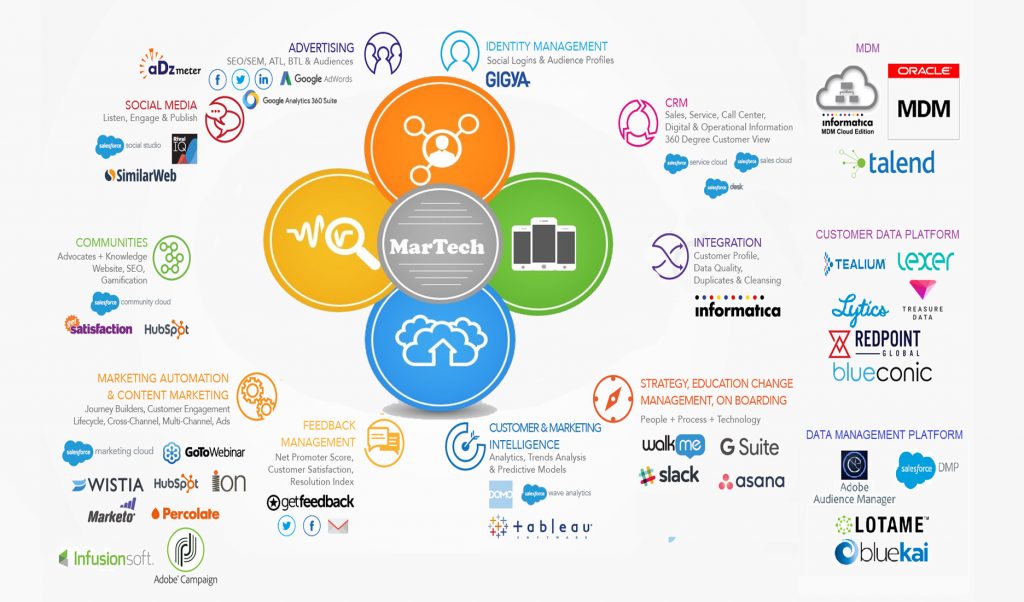
Marketing Technology Stack Infographic: Talk Walker
Talk Walker is social media analytics and monitoring platform that provides their customers with consumer insights and improves brands’ reputation.
They have developed a customer journey marketing technology stack in the form of a circle with different kinds of software tools at each step of the journey.
Talk Walker’s tech stack provides users with the main platforms that are universal and can be recommended to any business.

Marketing Tech Stack 2021: Egnyte
Egnyte, a content services platform, created an infographic of the technology stack they are using on a daily basis.
They focus mostly on execution and using data to make informed decisions and break their marketing tech stack into six segments:
- Data Management and Analytics
- Content Creation and Delivery
- PR & Media Monitoring
- Social Engagement
- Operations
- Seo
Among numerous tools, Egnyte chooses to use Buffer and Google Search Console, which are popular technological tools among technology marketers.
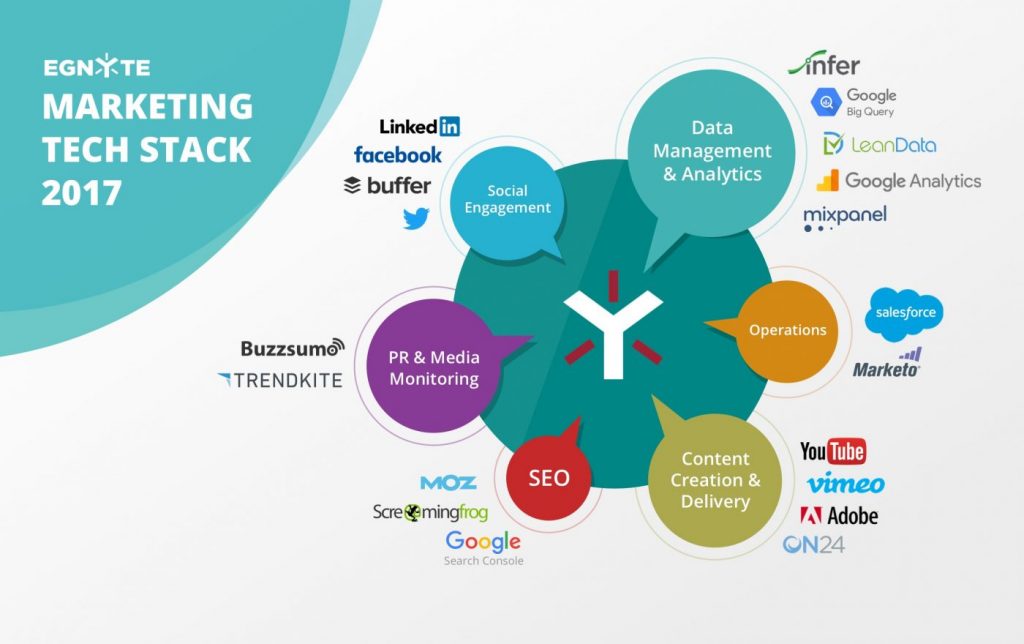
Digital Marketing Tools: Smart Insights
Smart Insights is a digital marketing strategy advice agency helping companies drive business growth.
As a starting point for their marketing technology stack, they used the customer lifecycle and then divided it into four main tech stack categories:
- Engage
- Reach
- Convert
- Act
As a result, there are 30 different purposes for many of the given tools. The company wants to try new tools and promote them over the ones which are on the market for a long time.
Smart Insights idea is to recommend new technology stack solutions and give companies ideas and insights of different tools on the market.
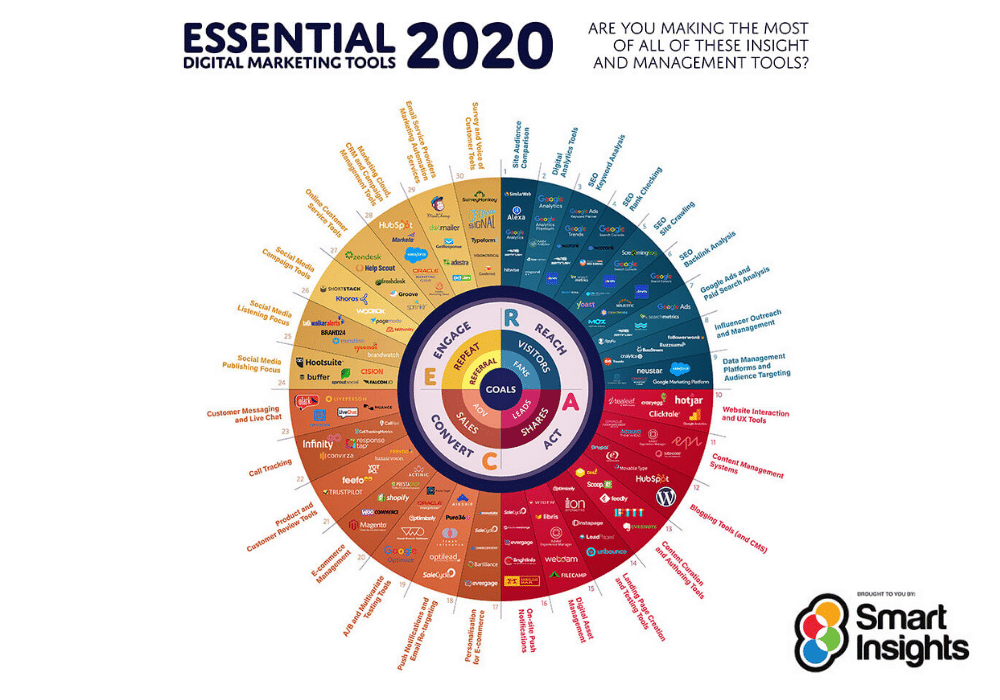
Martech Stack: Red Caffeine
Red Caffeine is a business and marketing growth strategy consulting creating marketing plans and growth strategies for their clients.
The infographic they presented depicts five groups with a focus on the importance of the financial perspective while creating marketing stacks. The five groups are:
- Awareness / Promotion
- Interest Capture
- Analytics
- Lead Management
- Business Operations
Each of the groups is then divided into subgroups with different tools used for that particular stage. The table is extremely easy to follow and is organized in a way that clearly points to the best tools for each process.
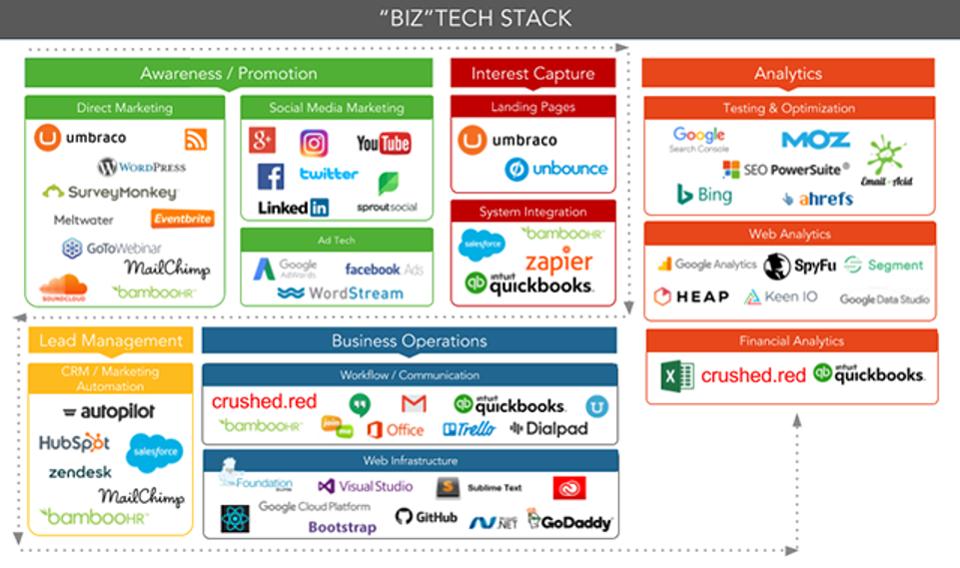
Martech Stack Examples: AdRoll
A recipe for team success was presented by Adroll with their marketing tech tools.
The marketing tools in this example are divided into six main parts and fit into the funnel based on user behavior.
Thanks to the division into smaller blocks, is easy for the reader to navigate. What’s more, the arrows help users see which tools can be used together to connect different stages of the funnel.
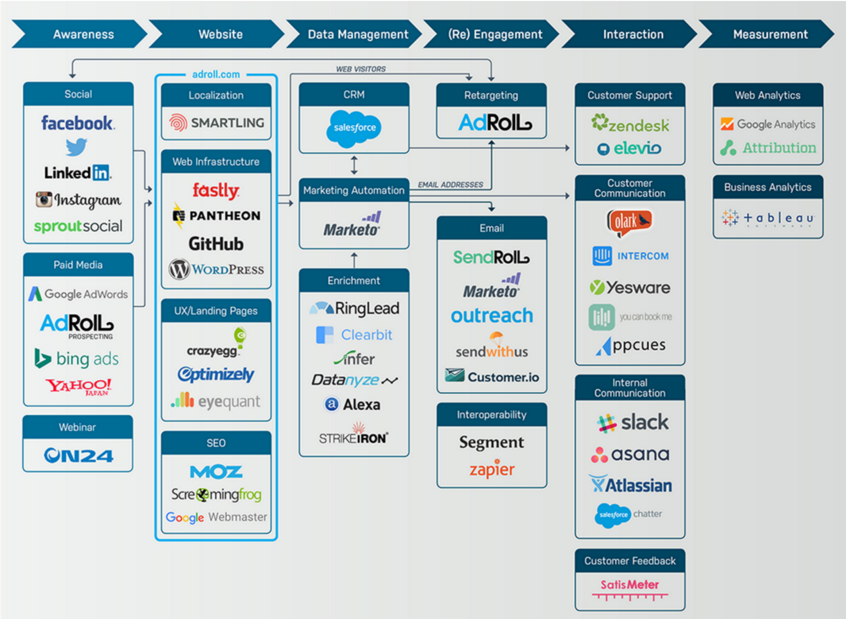
Conclusion
There is a variety of tools to choose from and go onto making a perfect digital marketing tech stack for any type of business.
One extra tip for successful execution and development of your very own martech stack is dividing your marketing efforts into phases or smaller processes.
After you segment your funnel, compare your needs with other companies’ solutions. It is worth checking out what your competitors are opting for too!
Moreover, remember that sometimes less is more. You don’t always need the largest quantity or the most expensive option. Some companies are better off with simple tech stacks, as they are easier to monitor and coordinate.
If you run into problems or extra questions, do not hesitate to reach out to us.
Here at Klint Marketing, we offer digital strategies, marketing stack implementations, and growth hacks for scaling businesses no matter the industry or size!

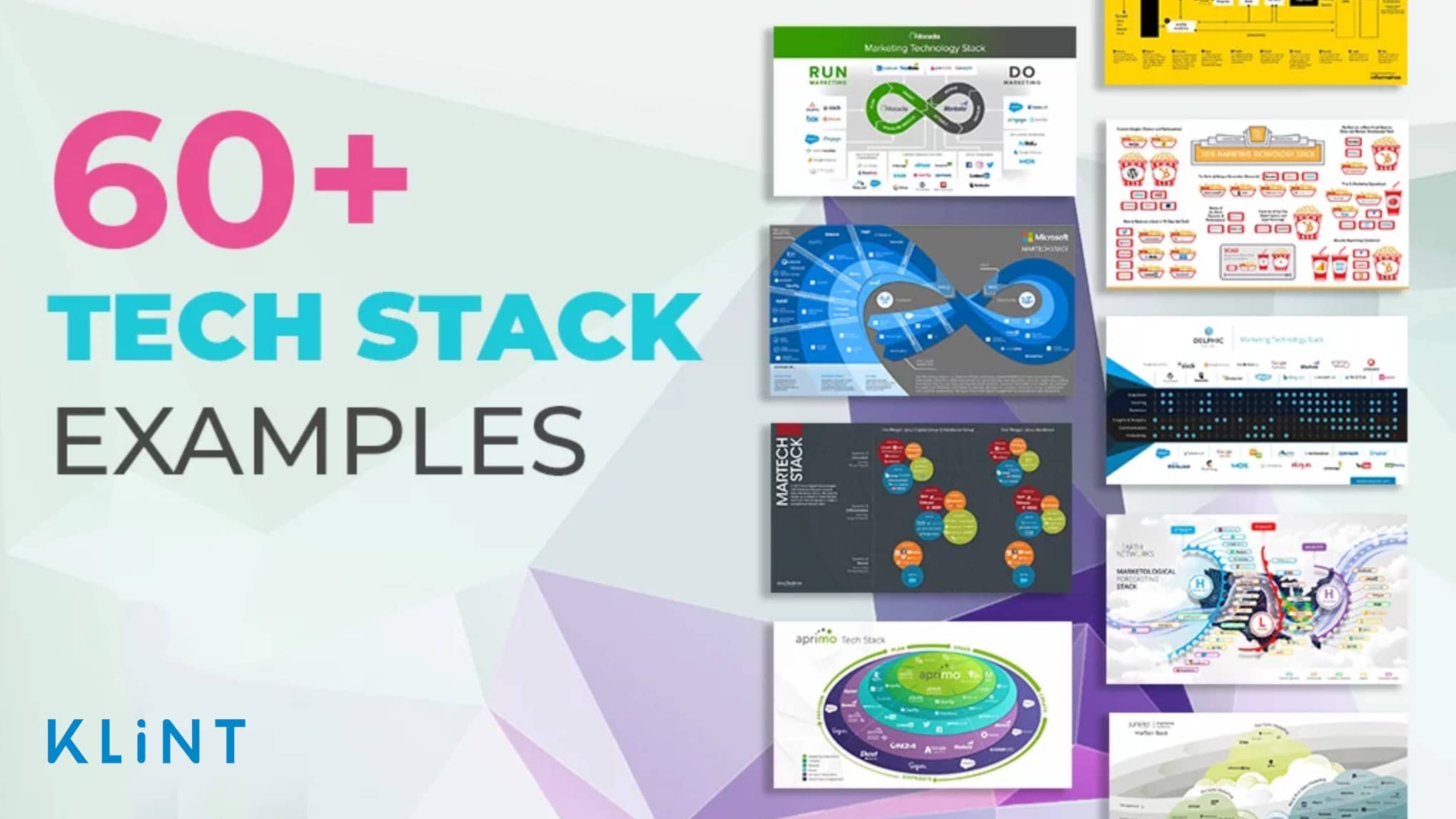
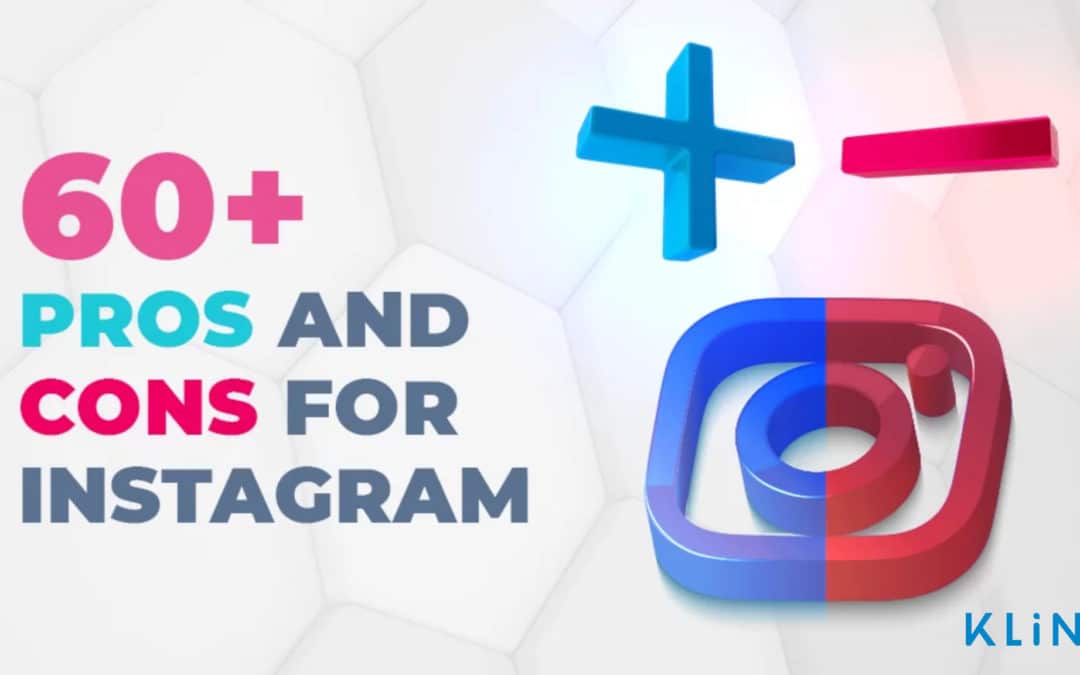
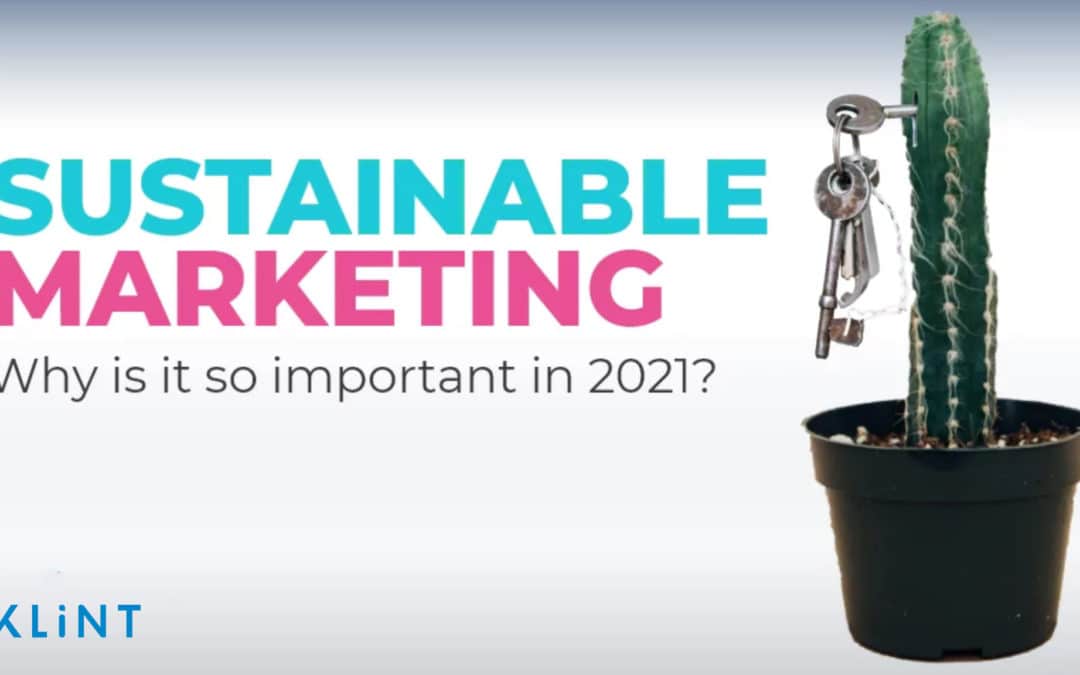

0 Comments